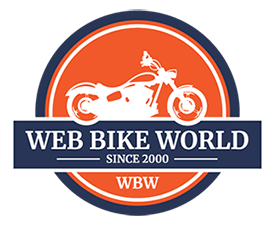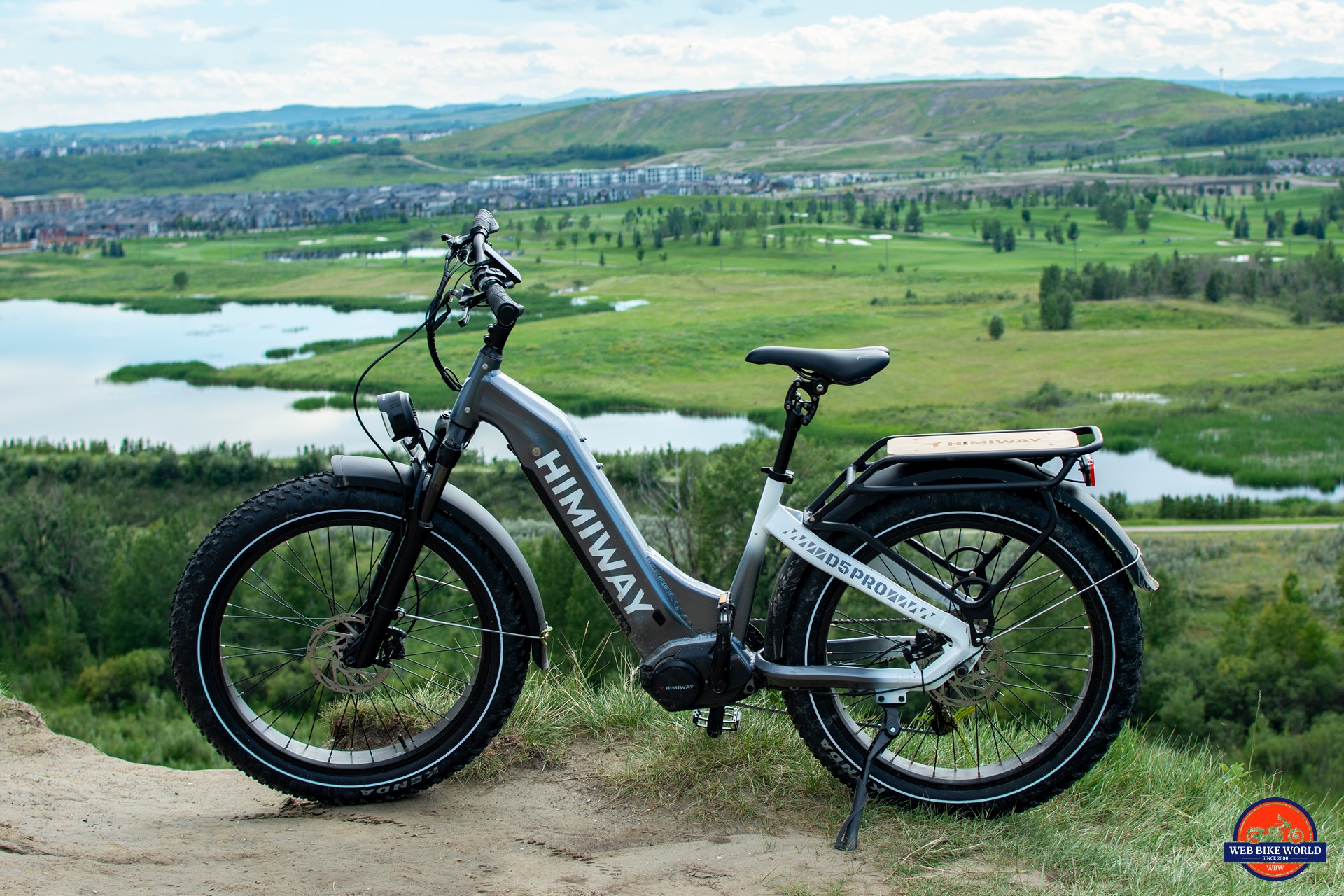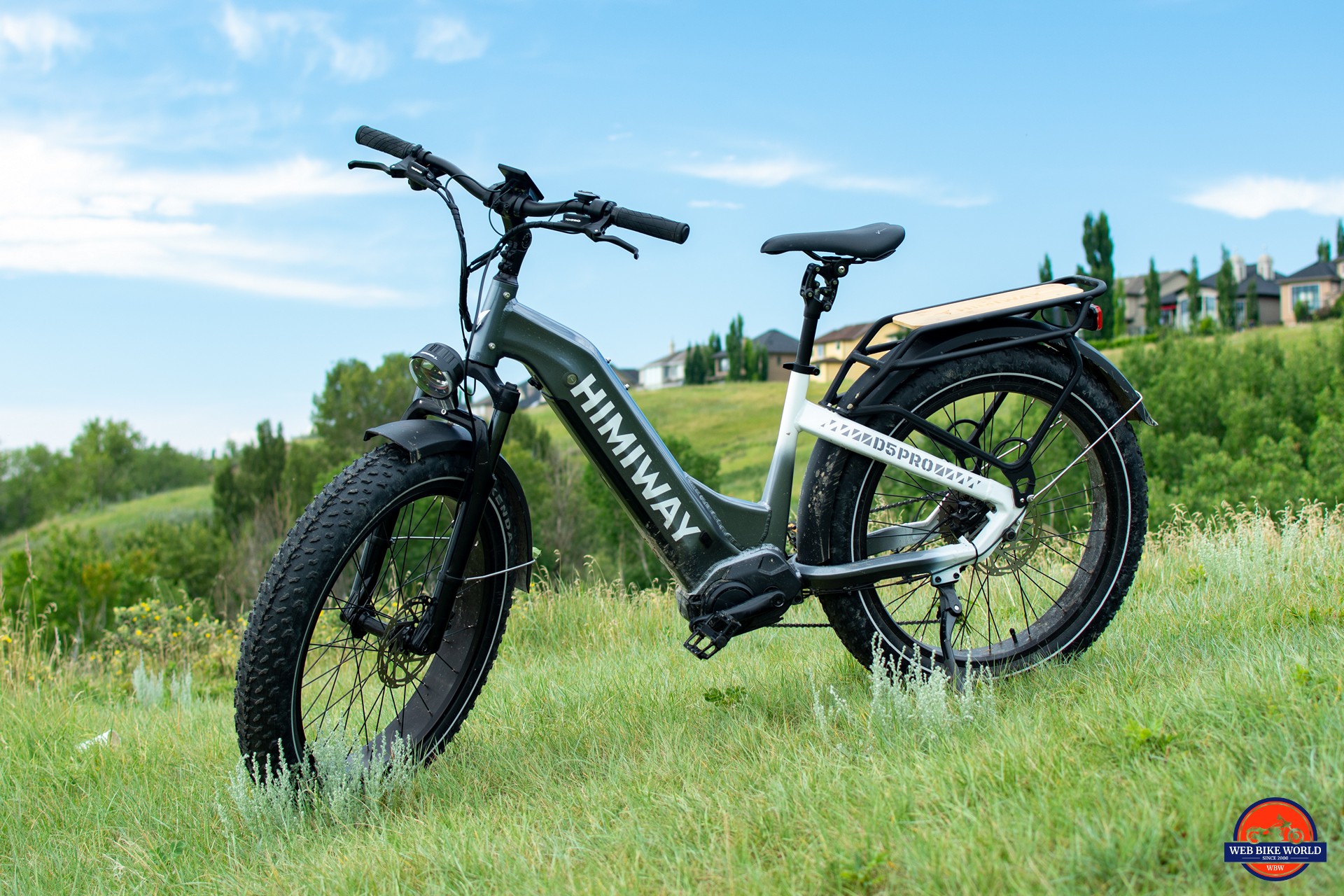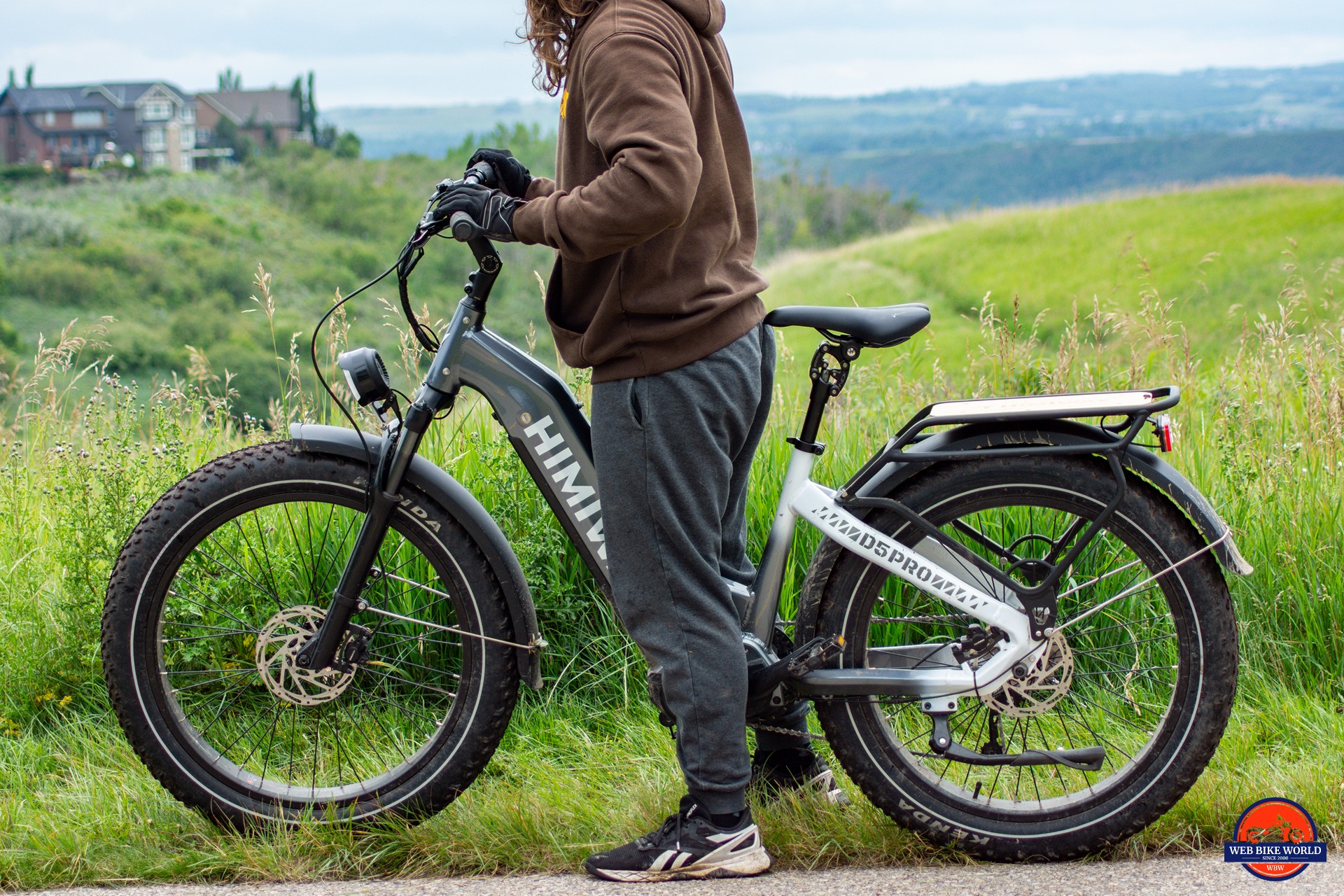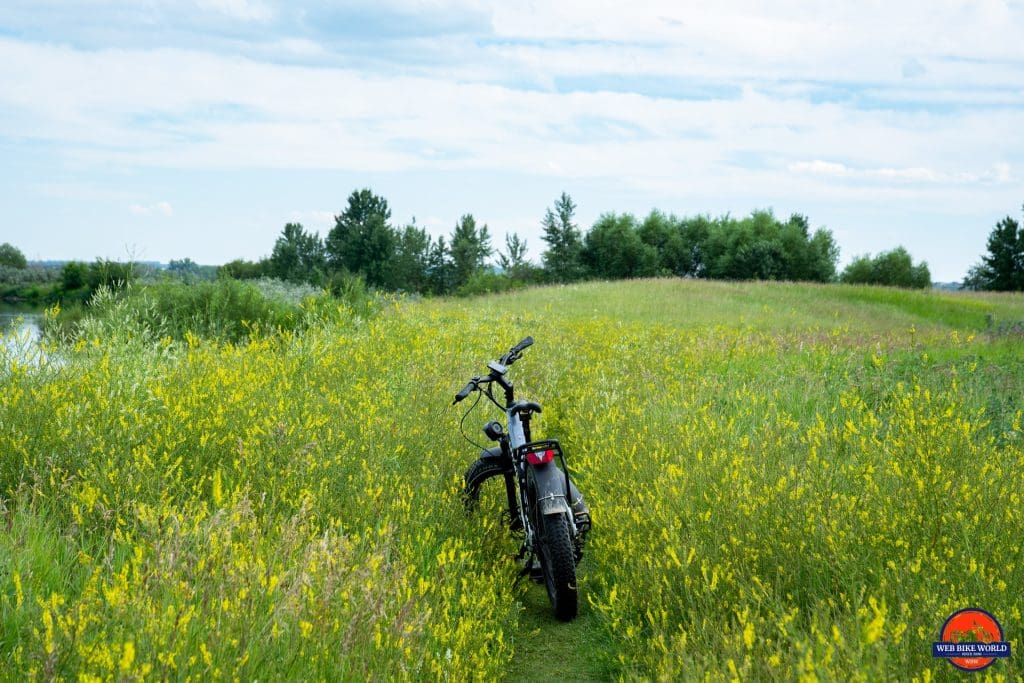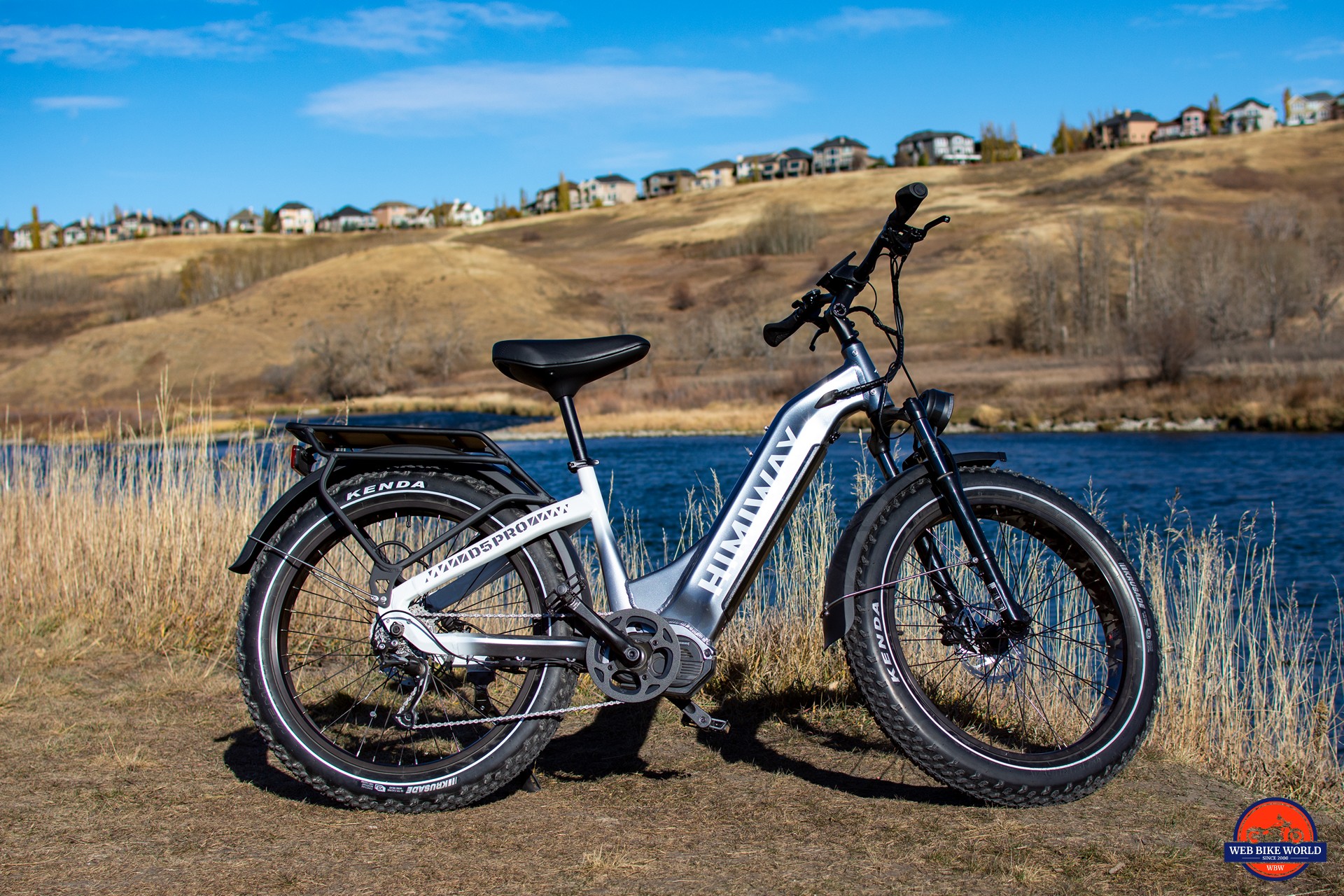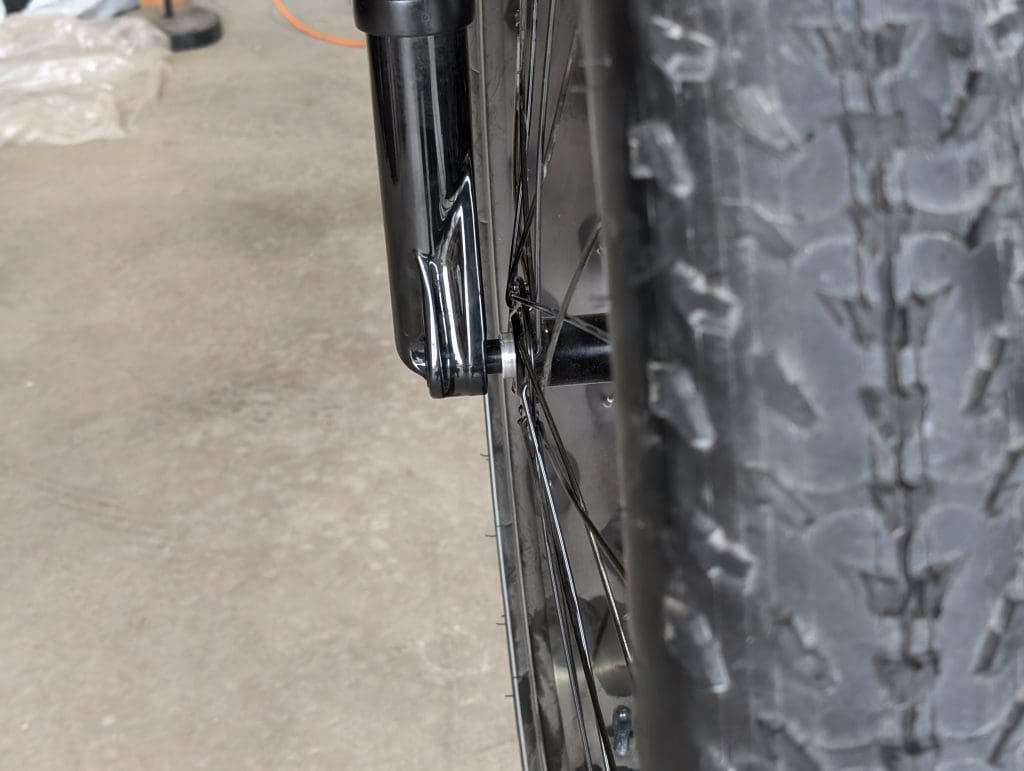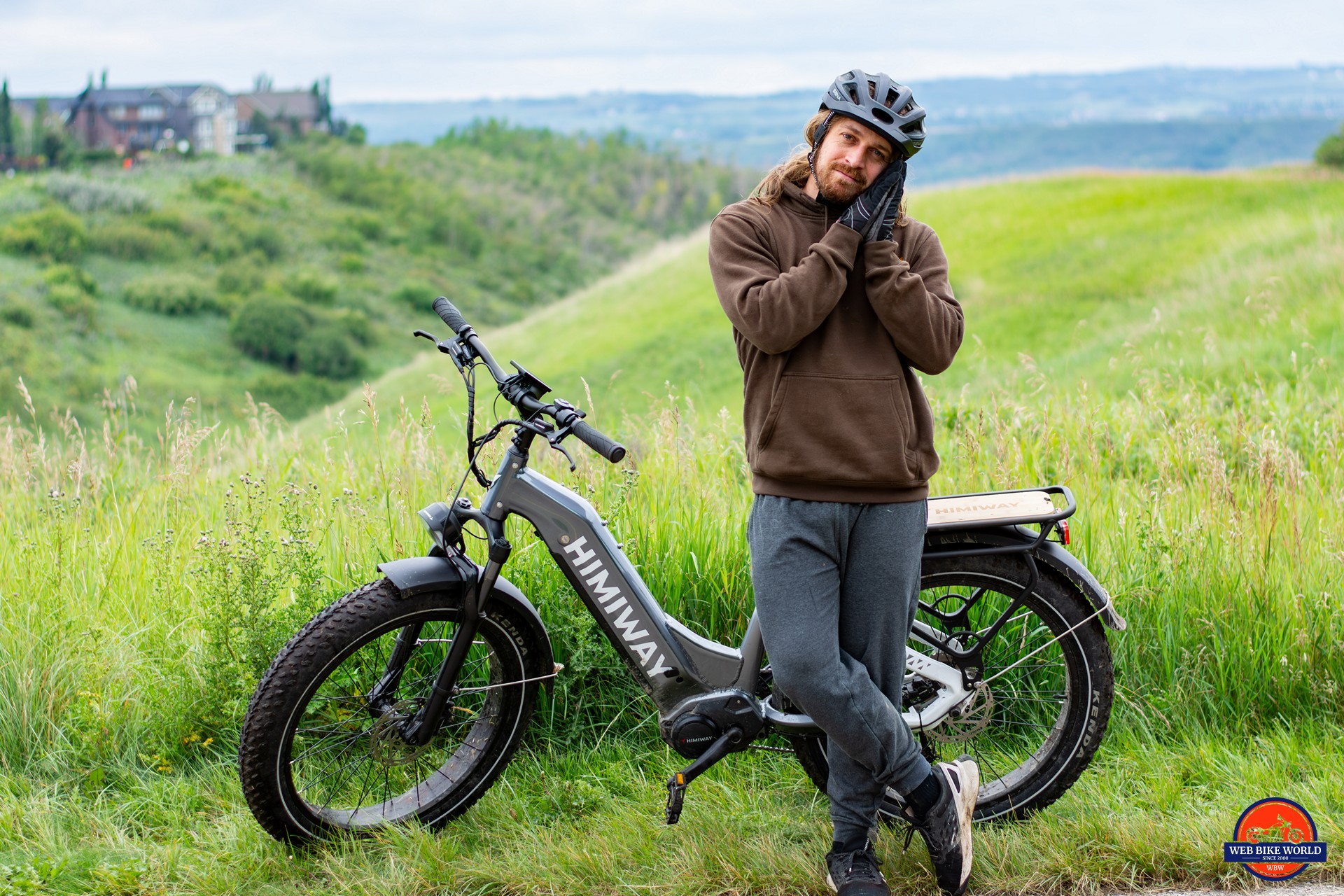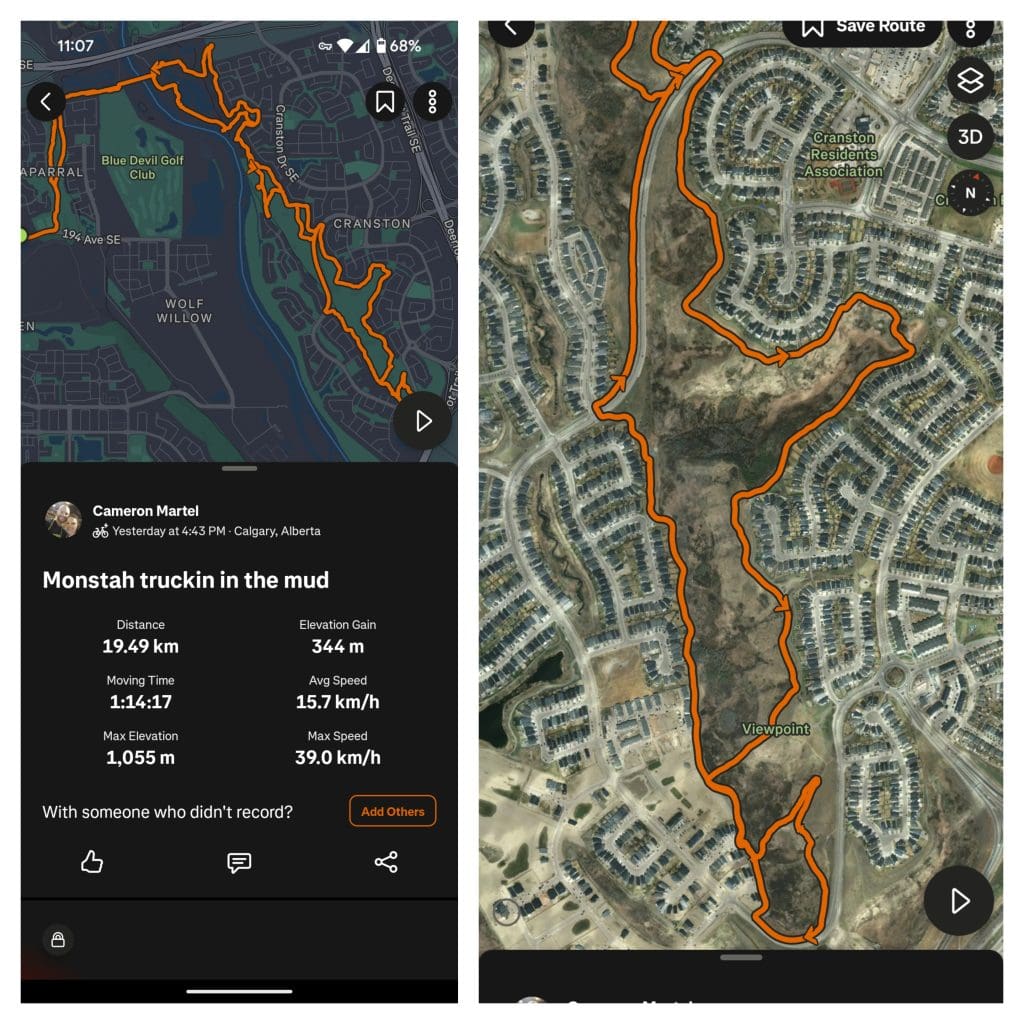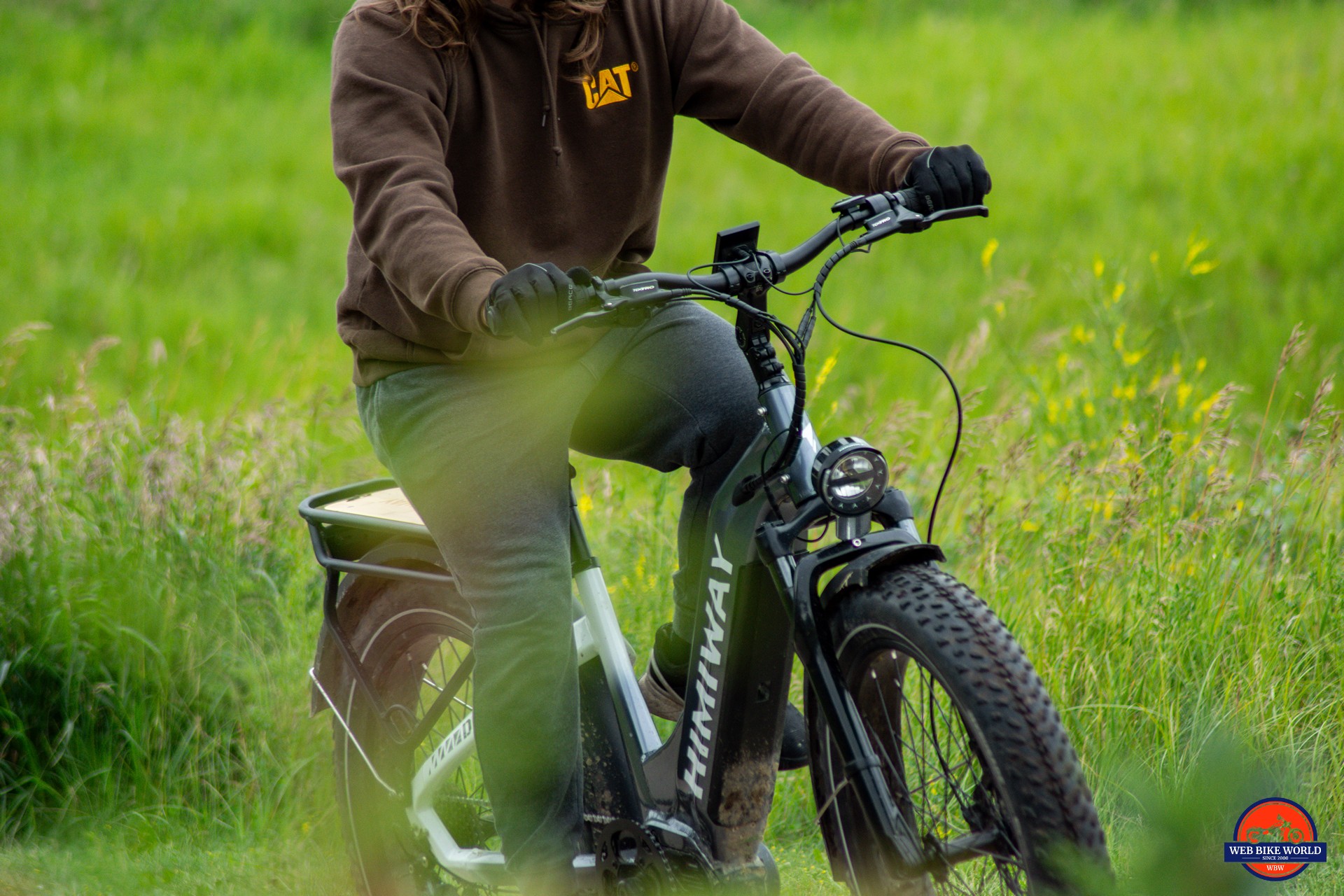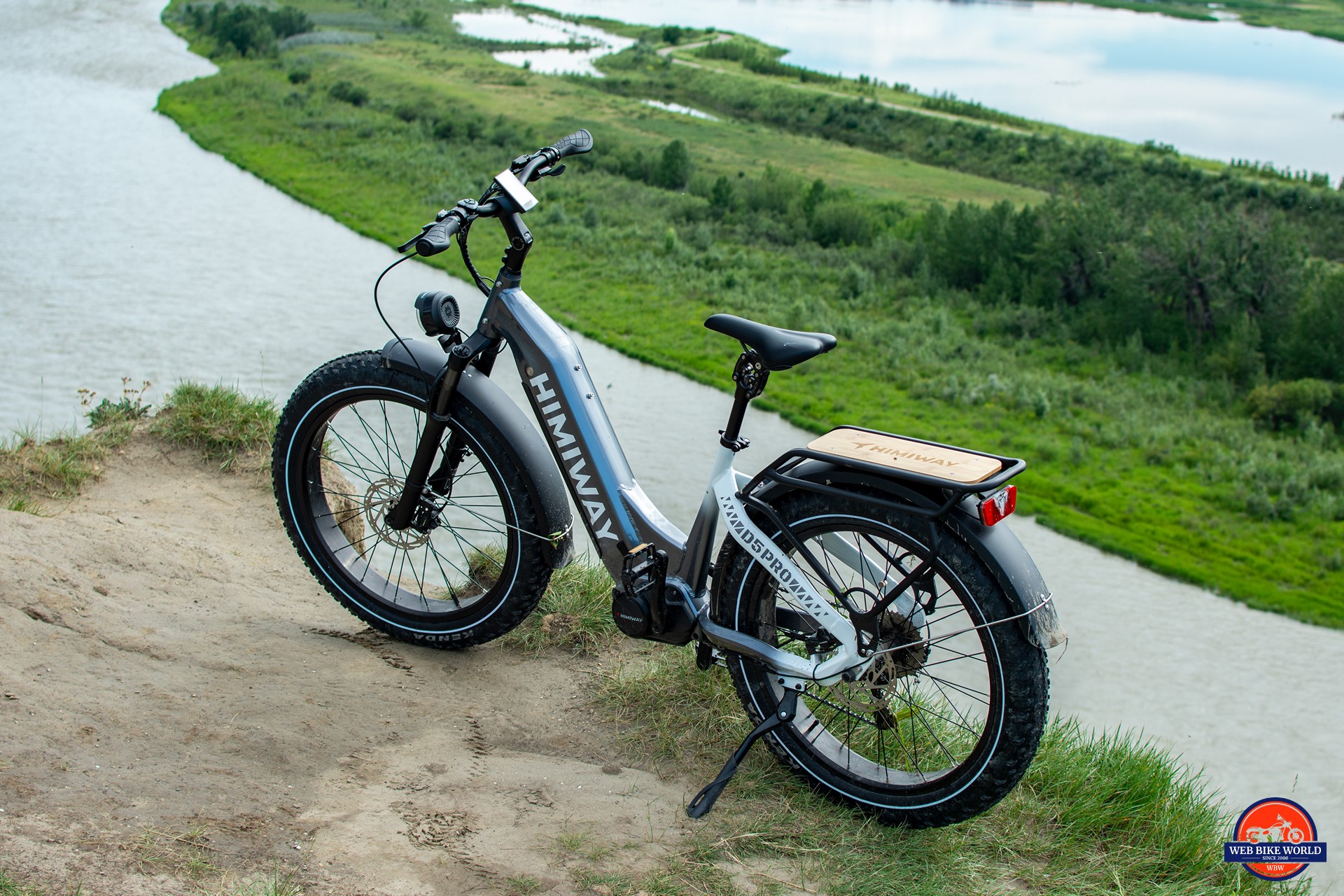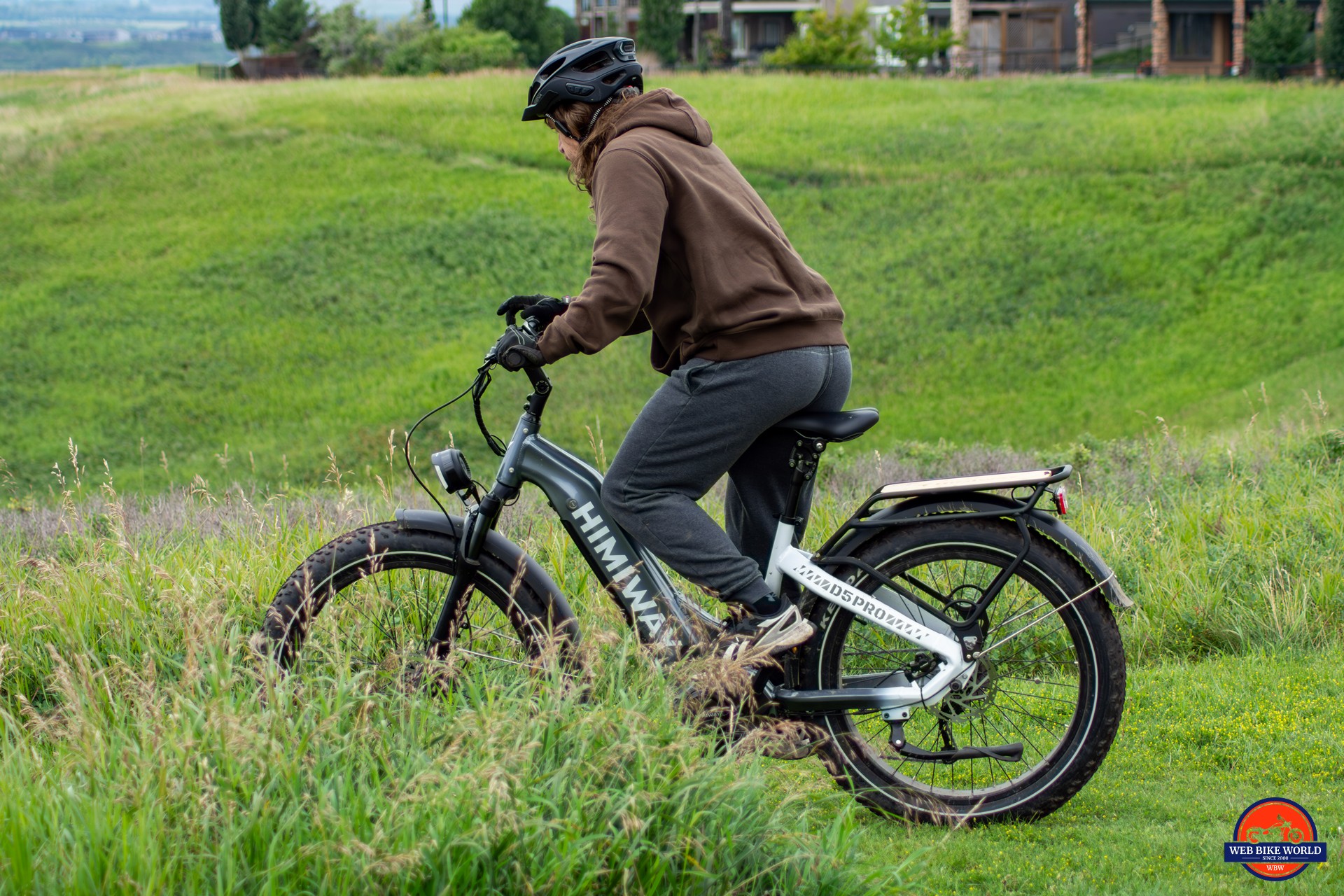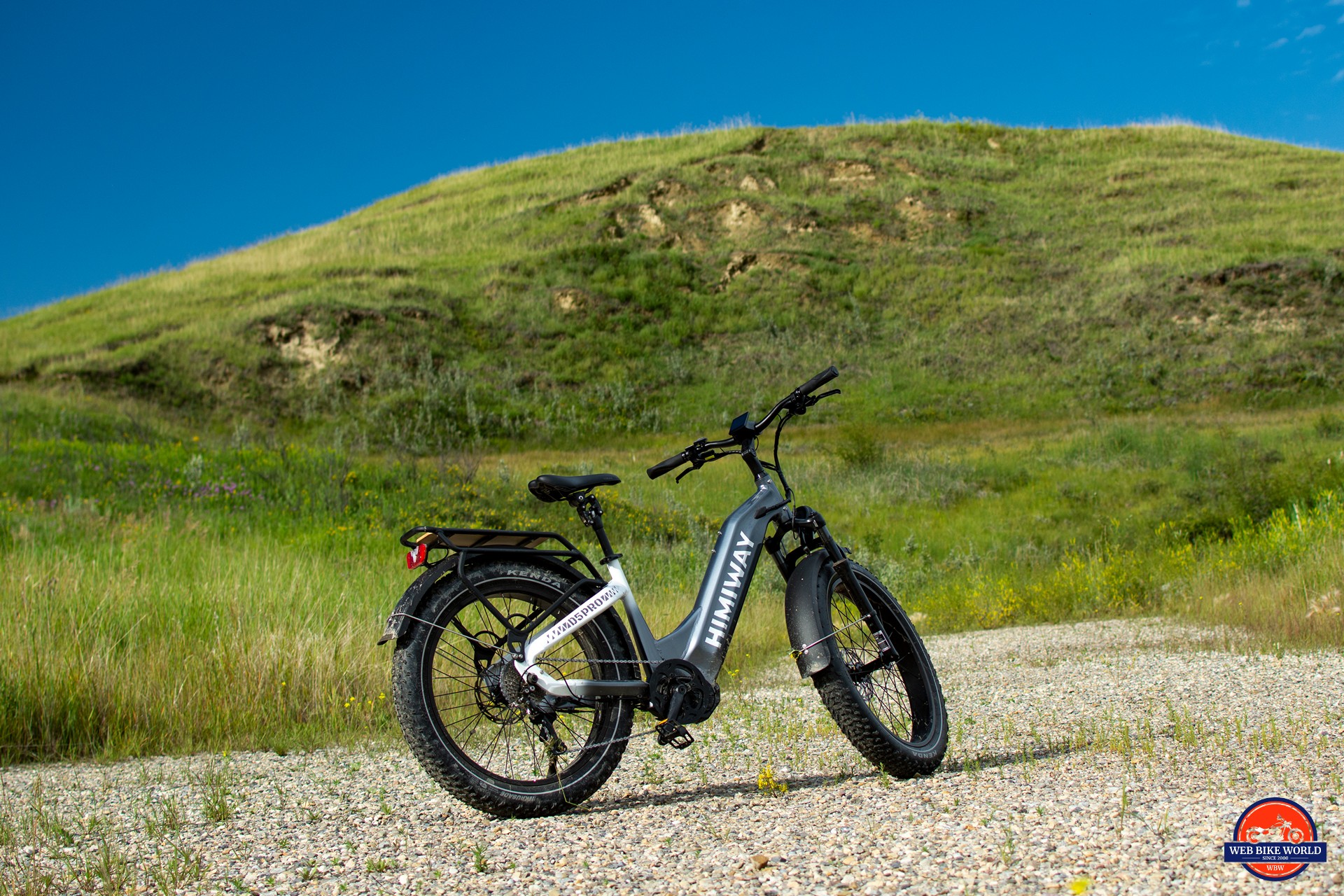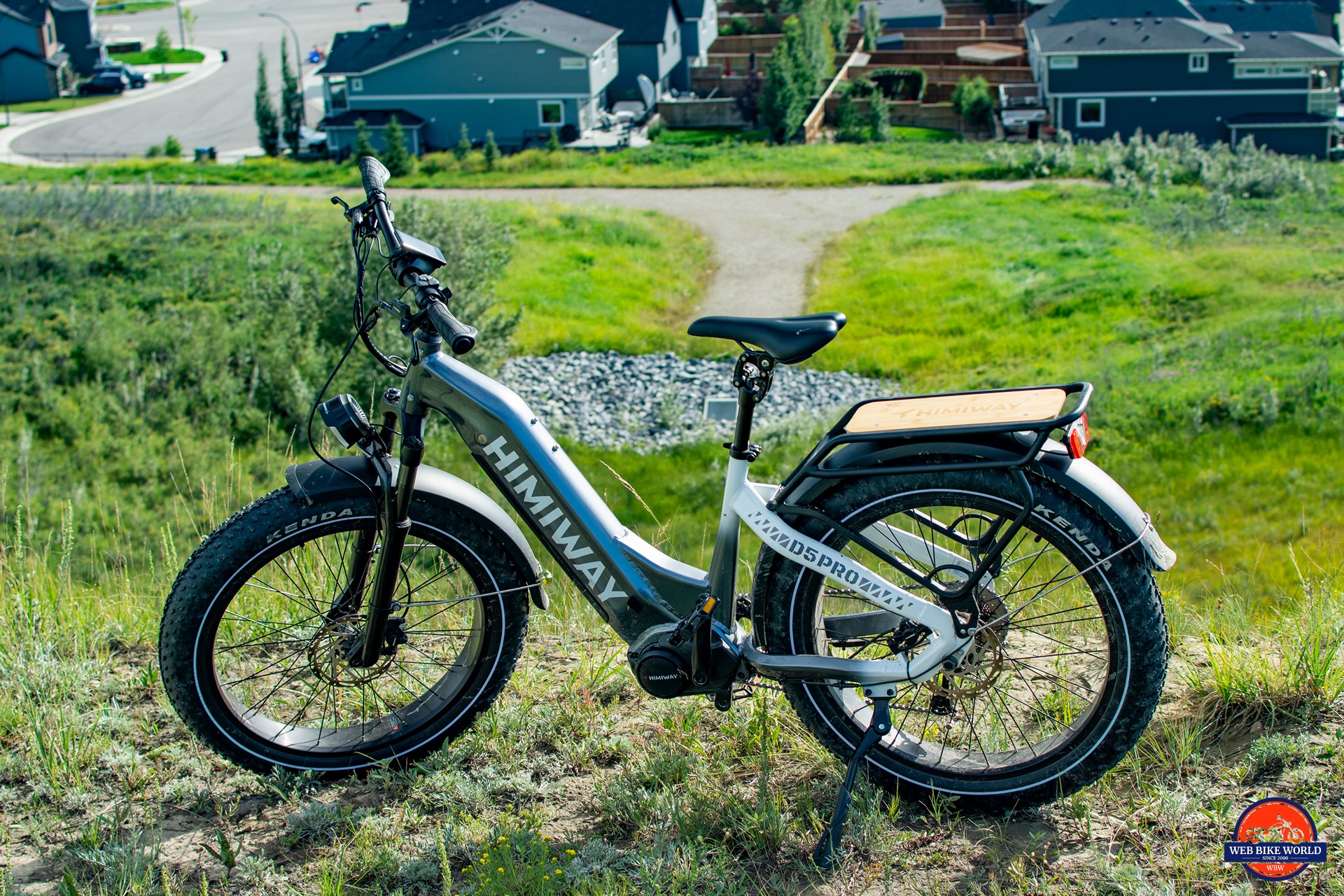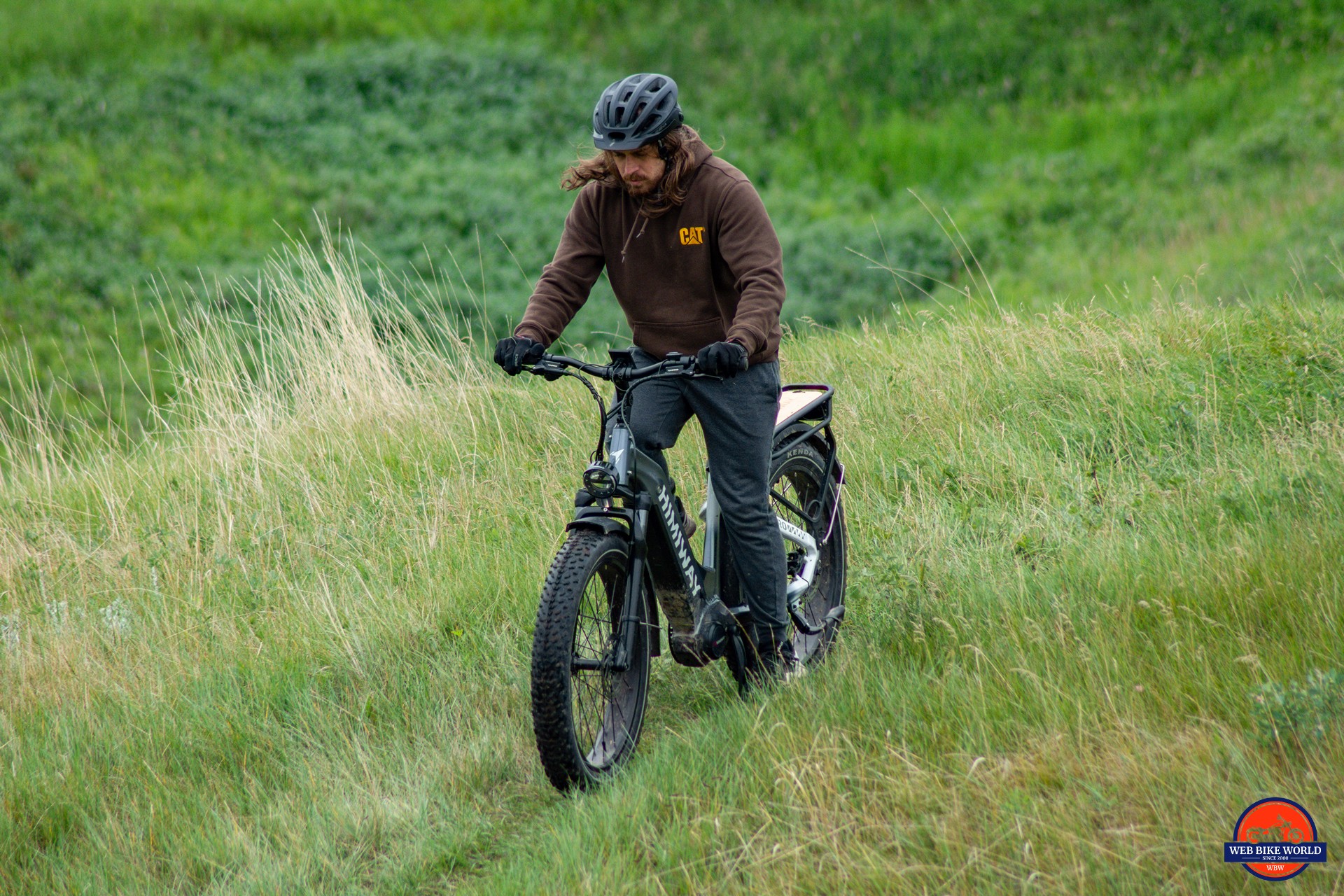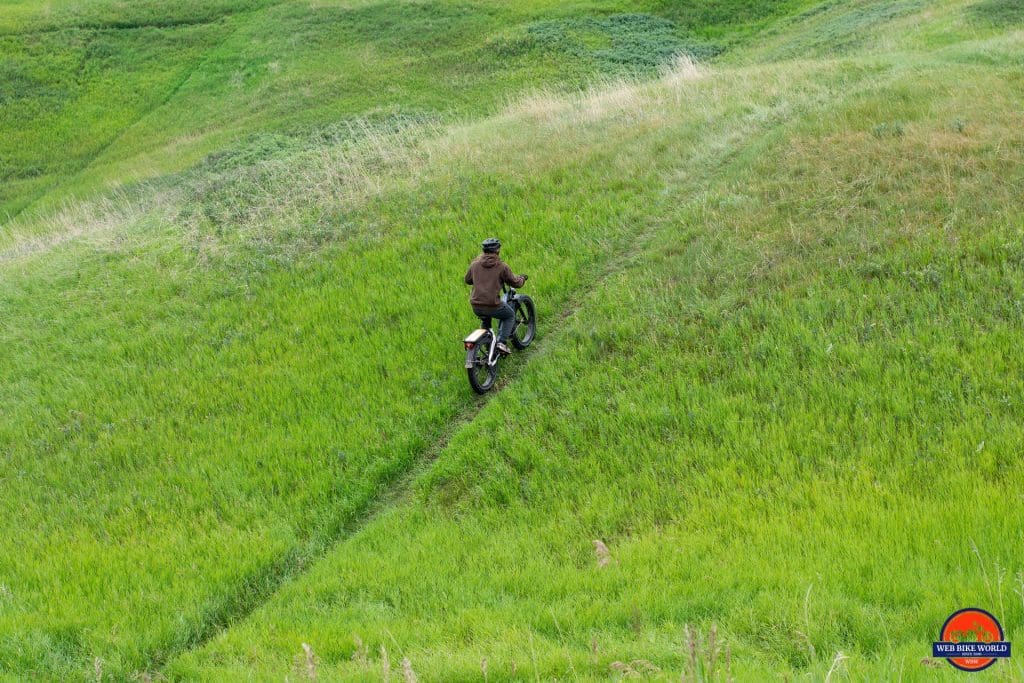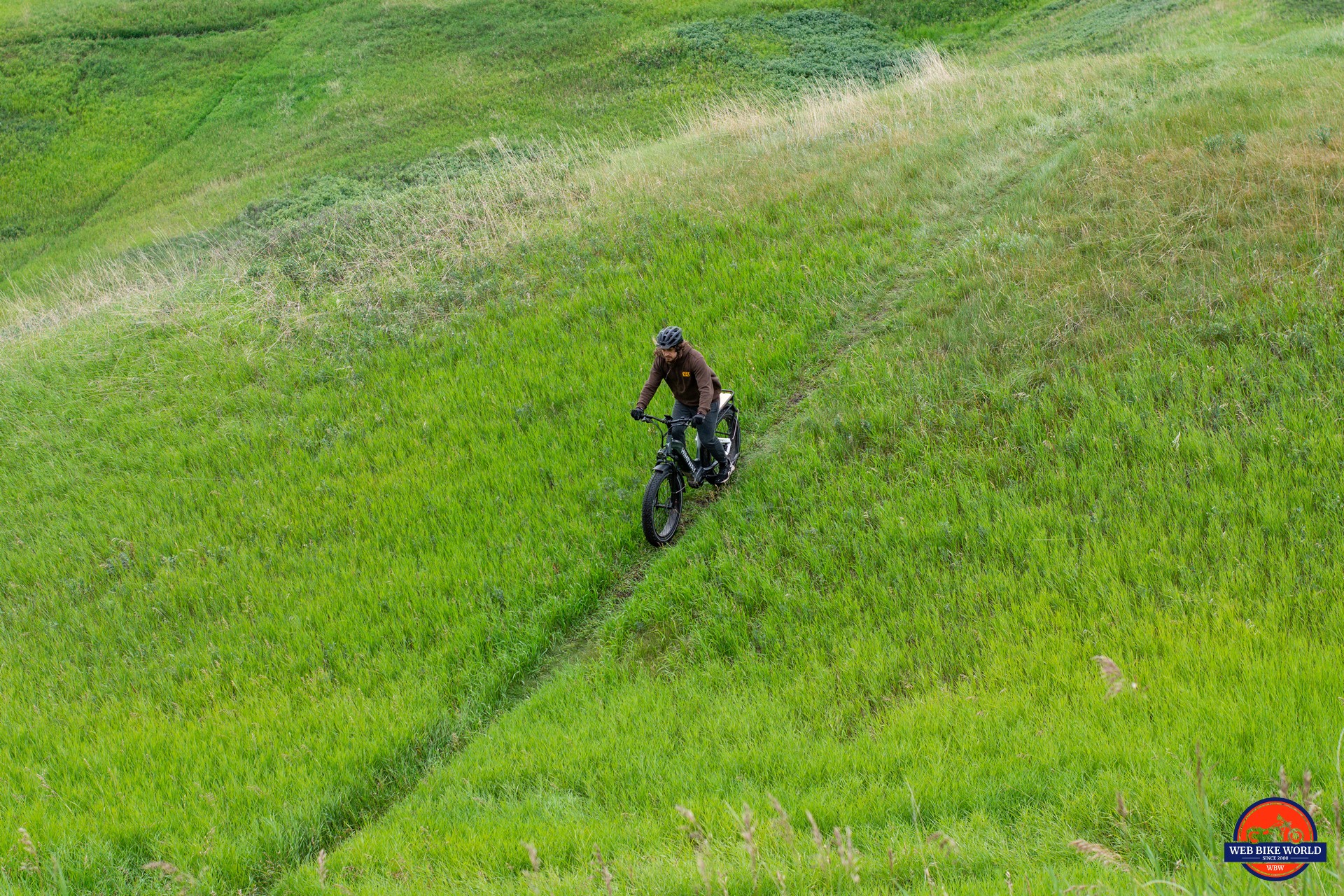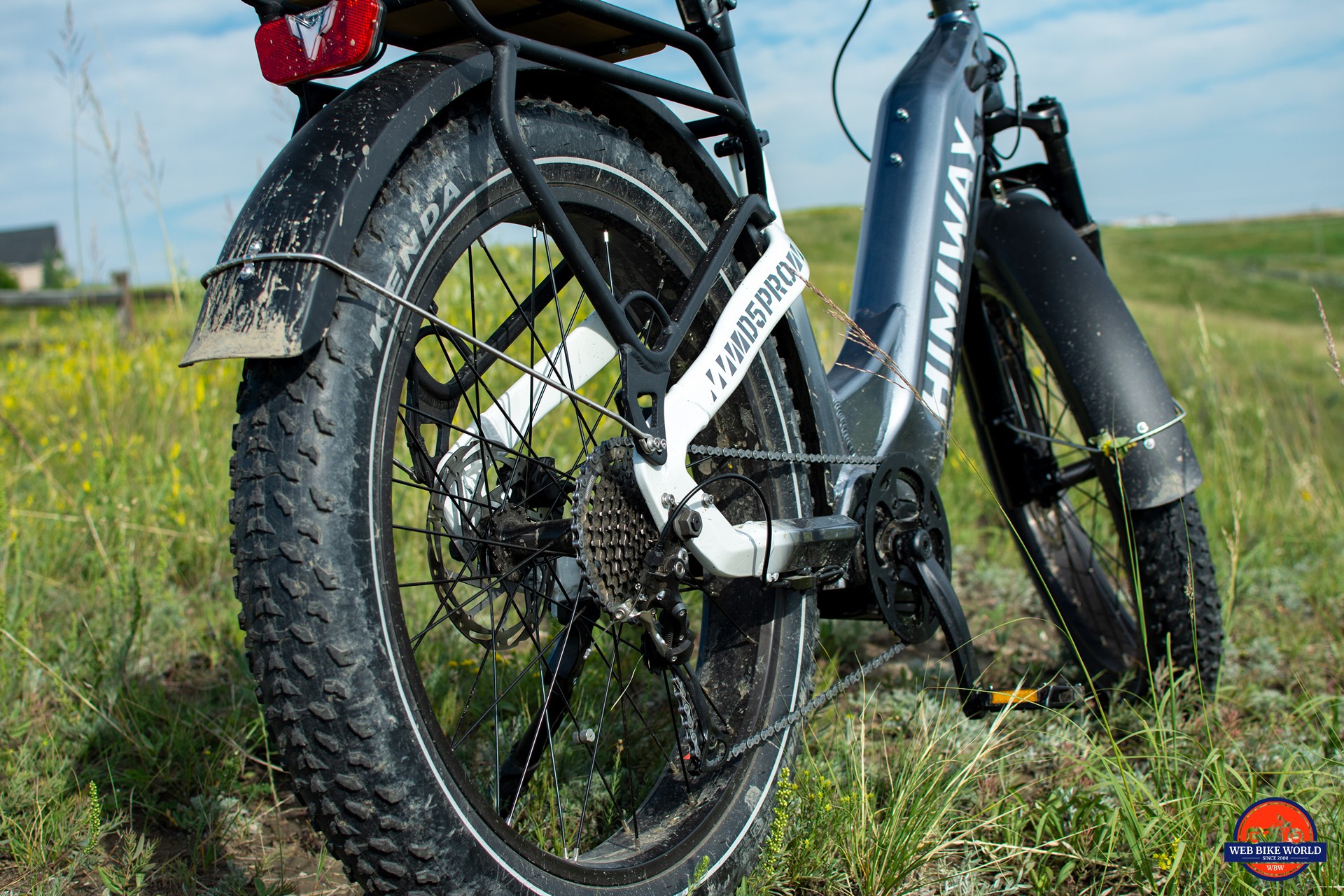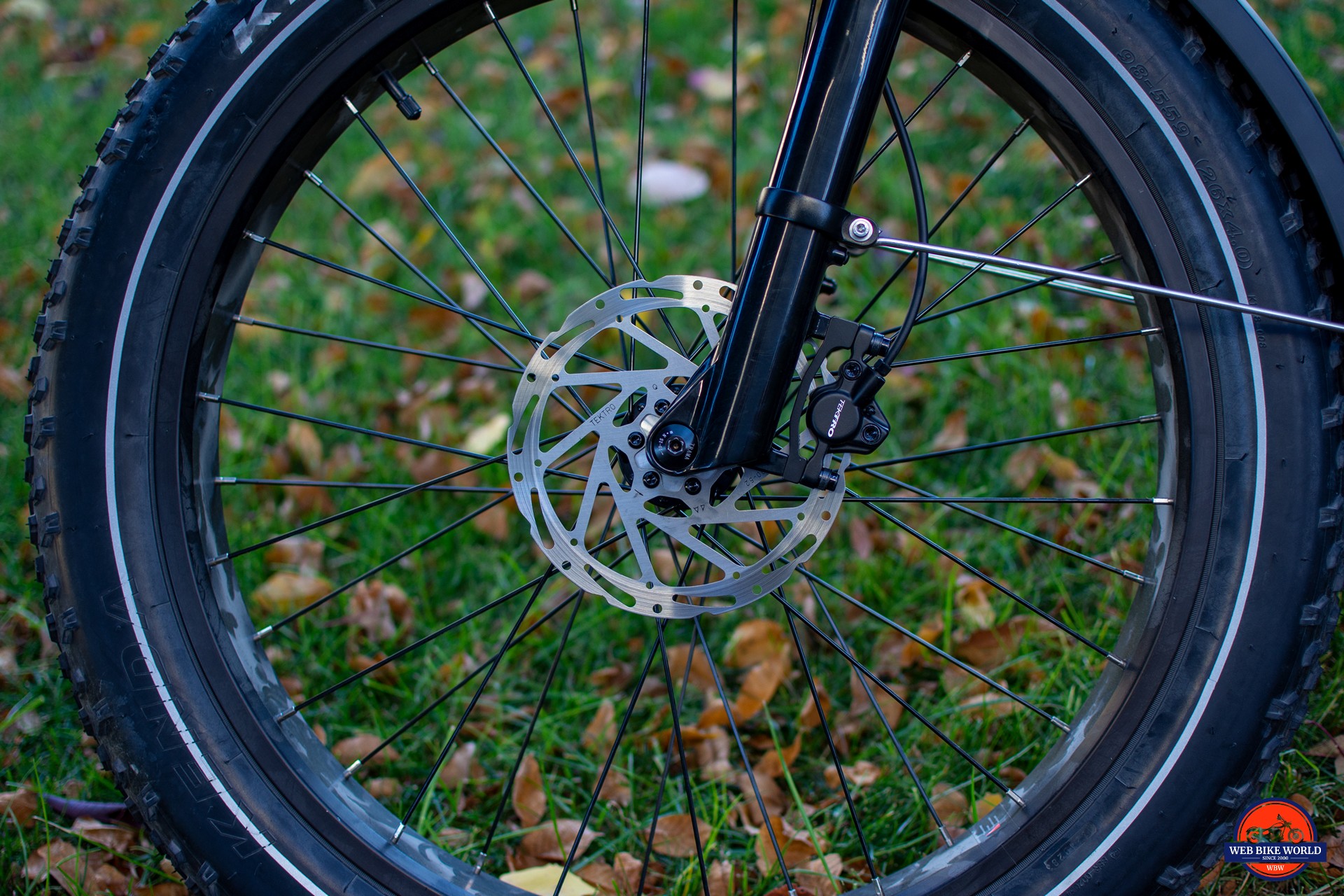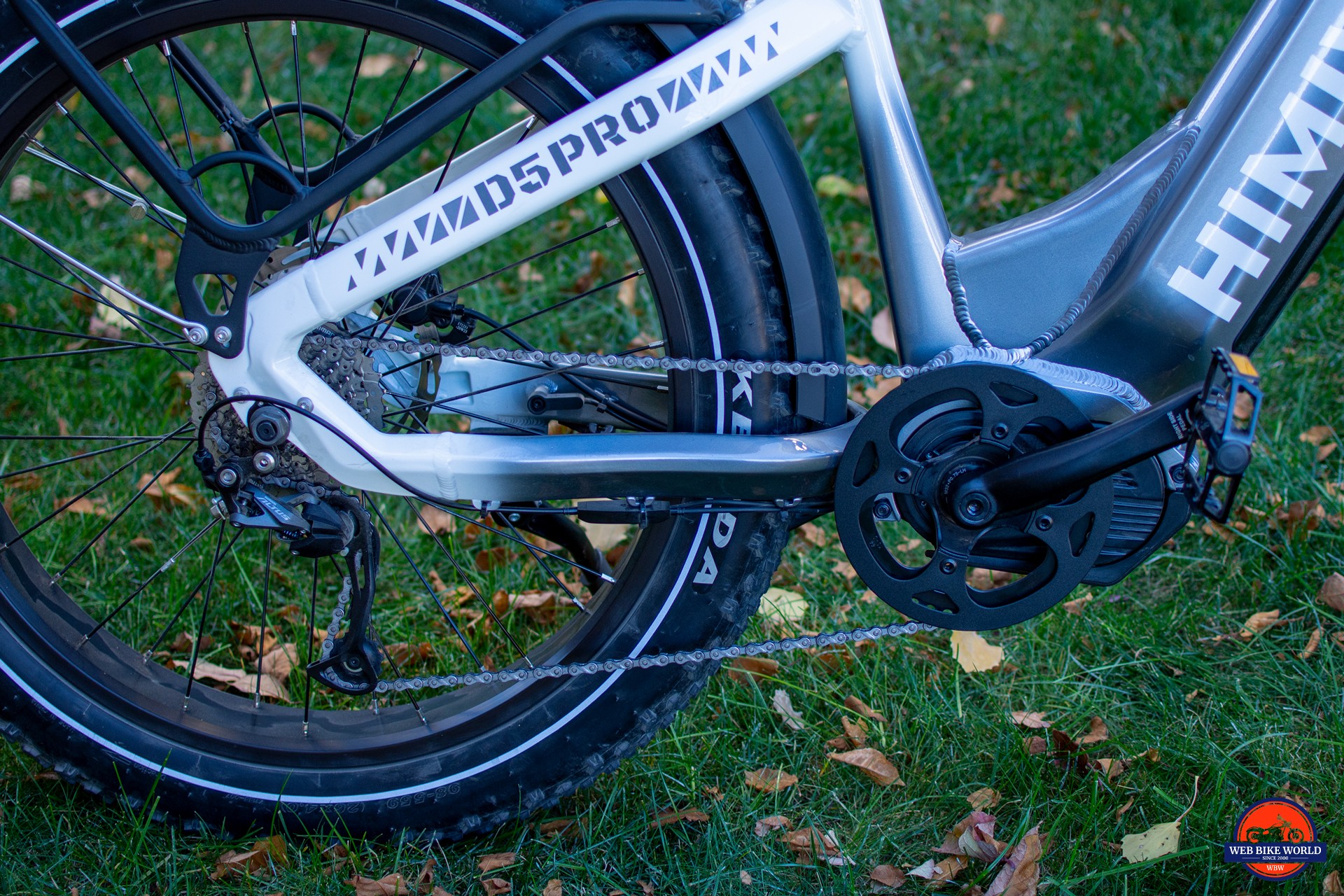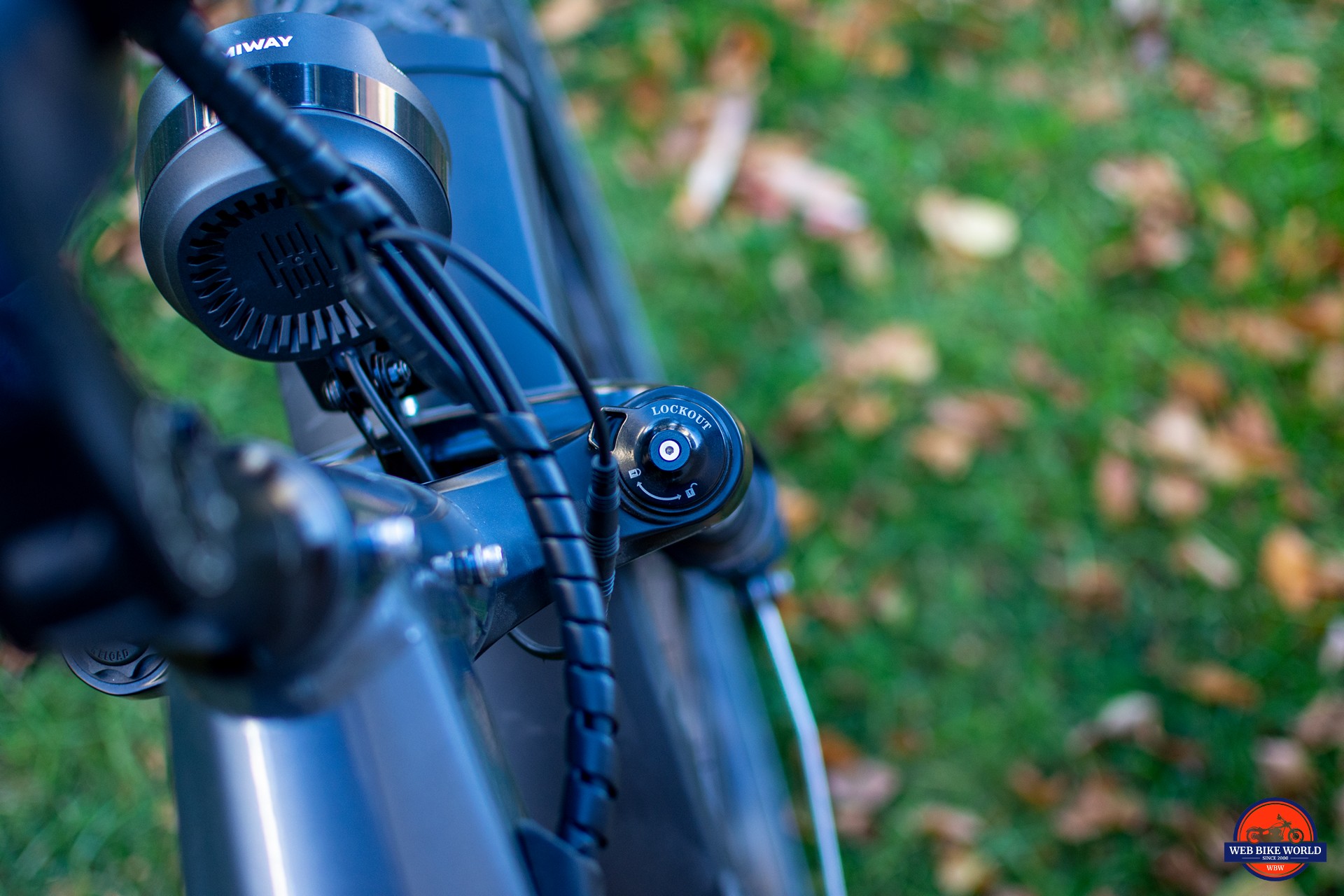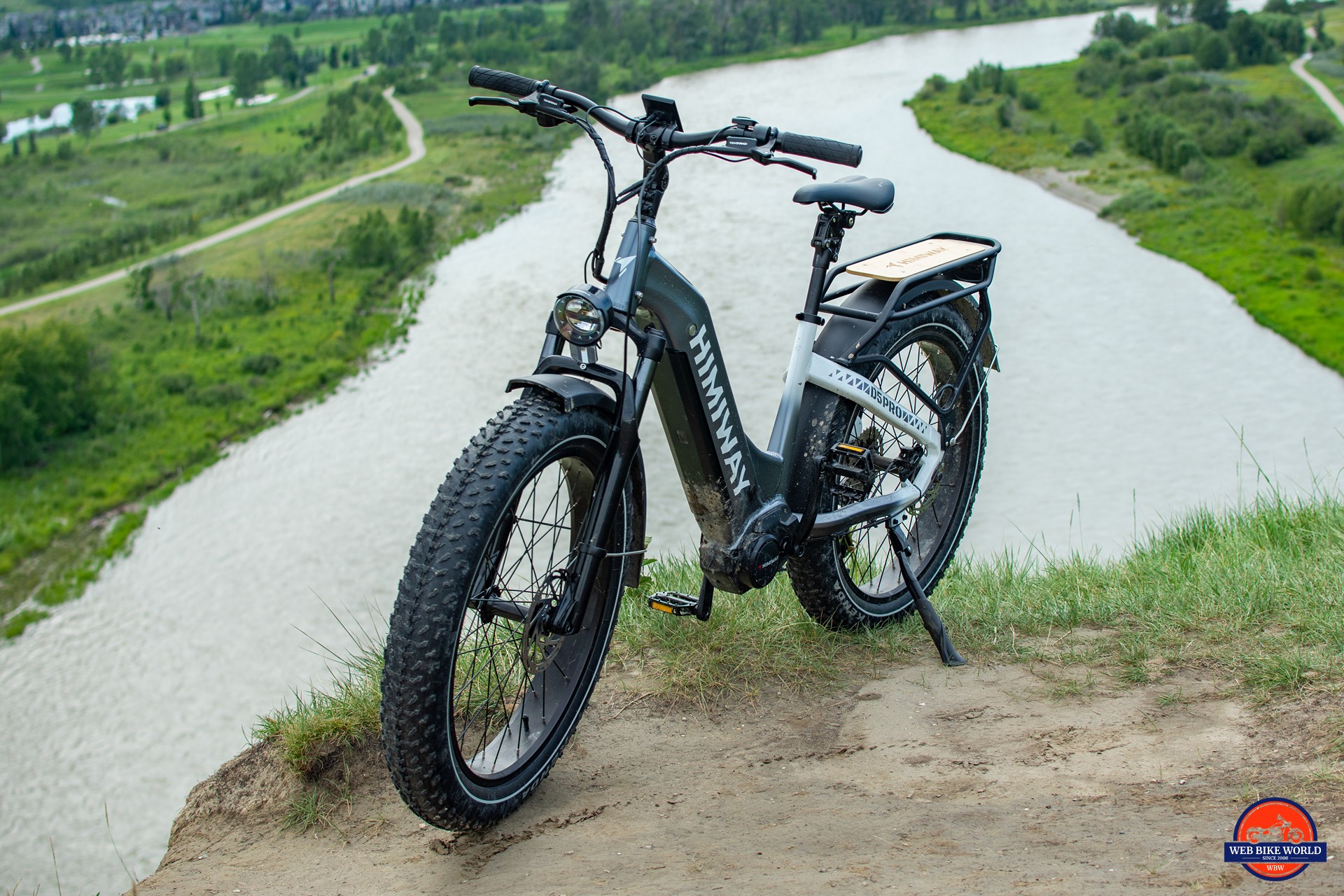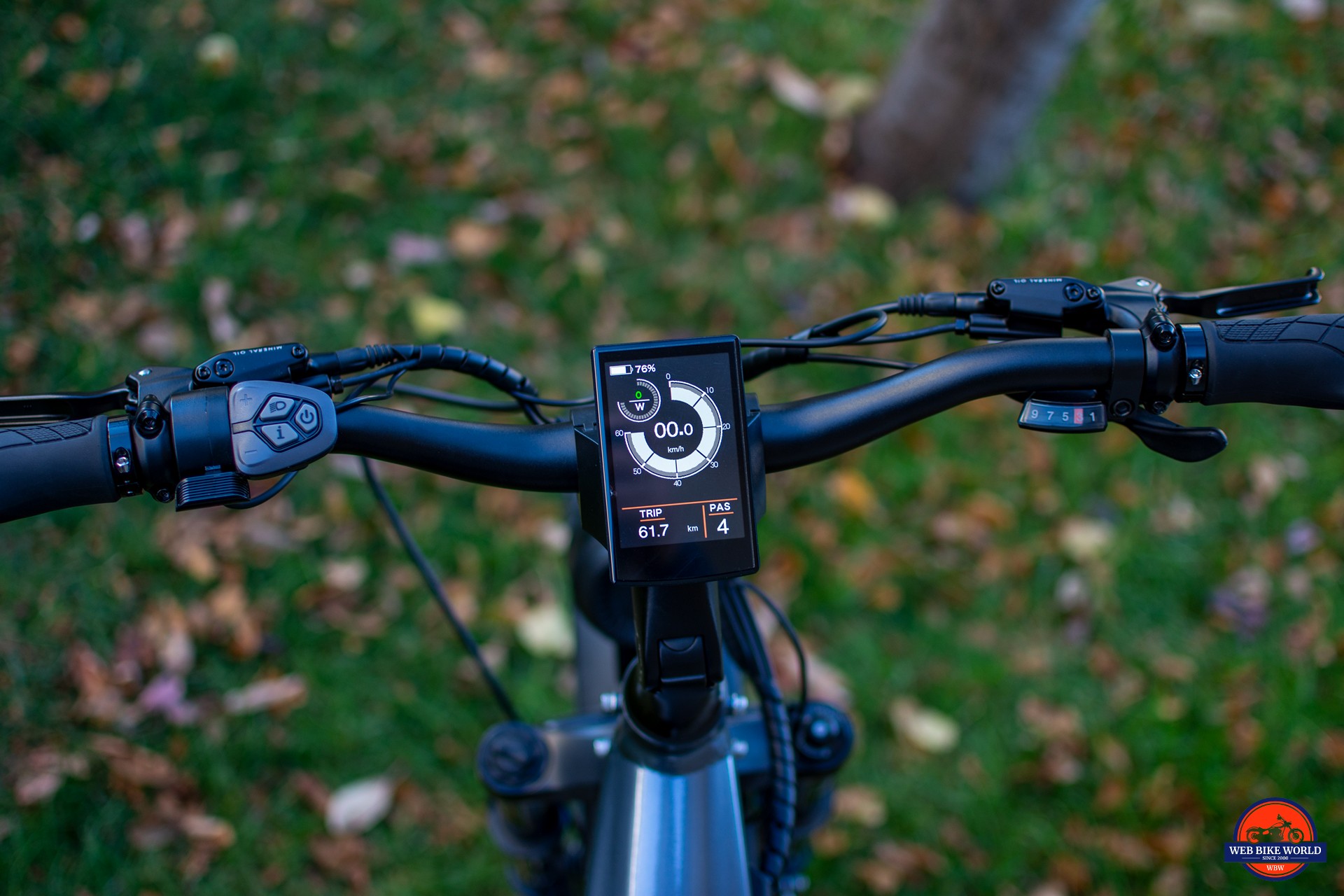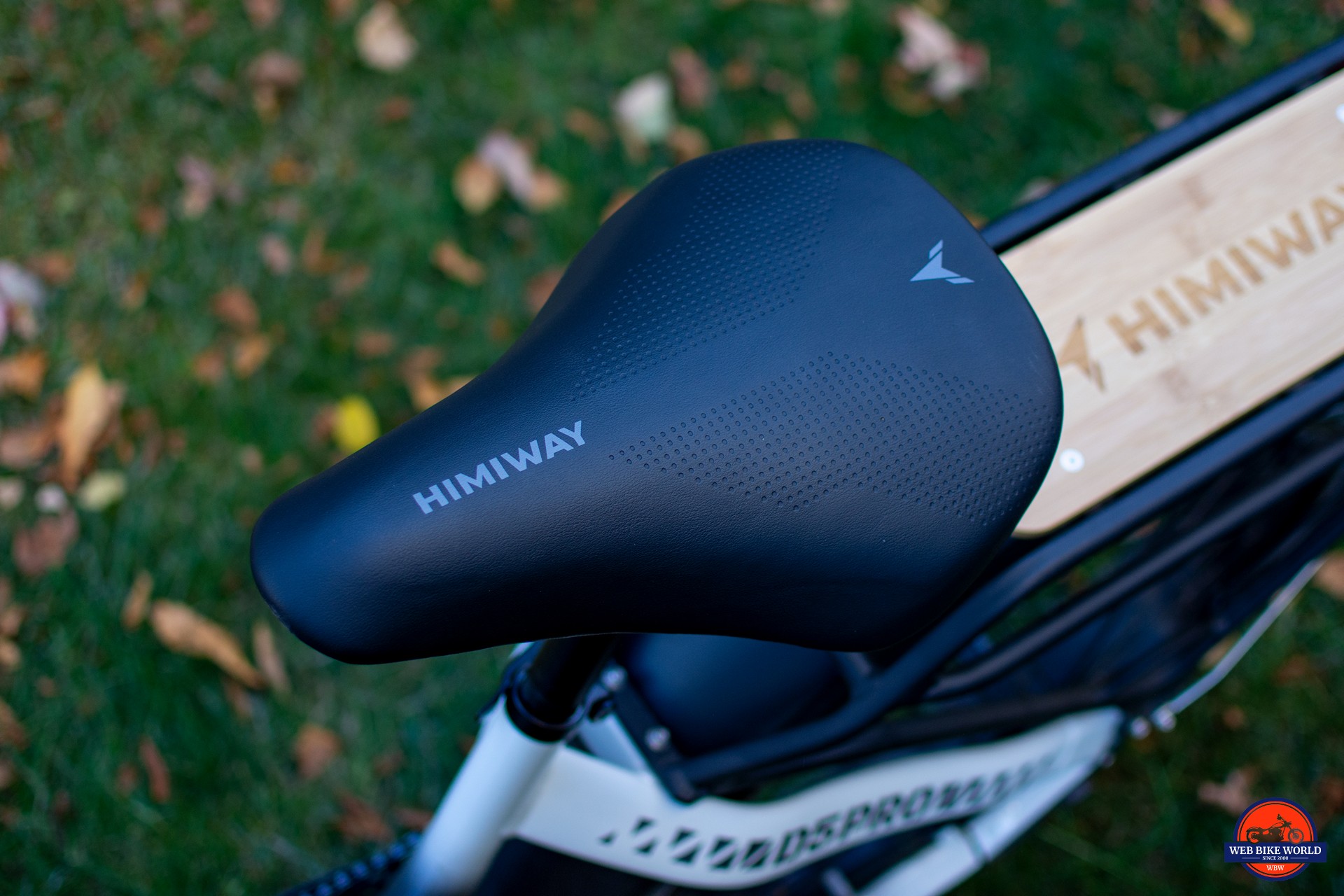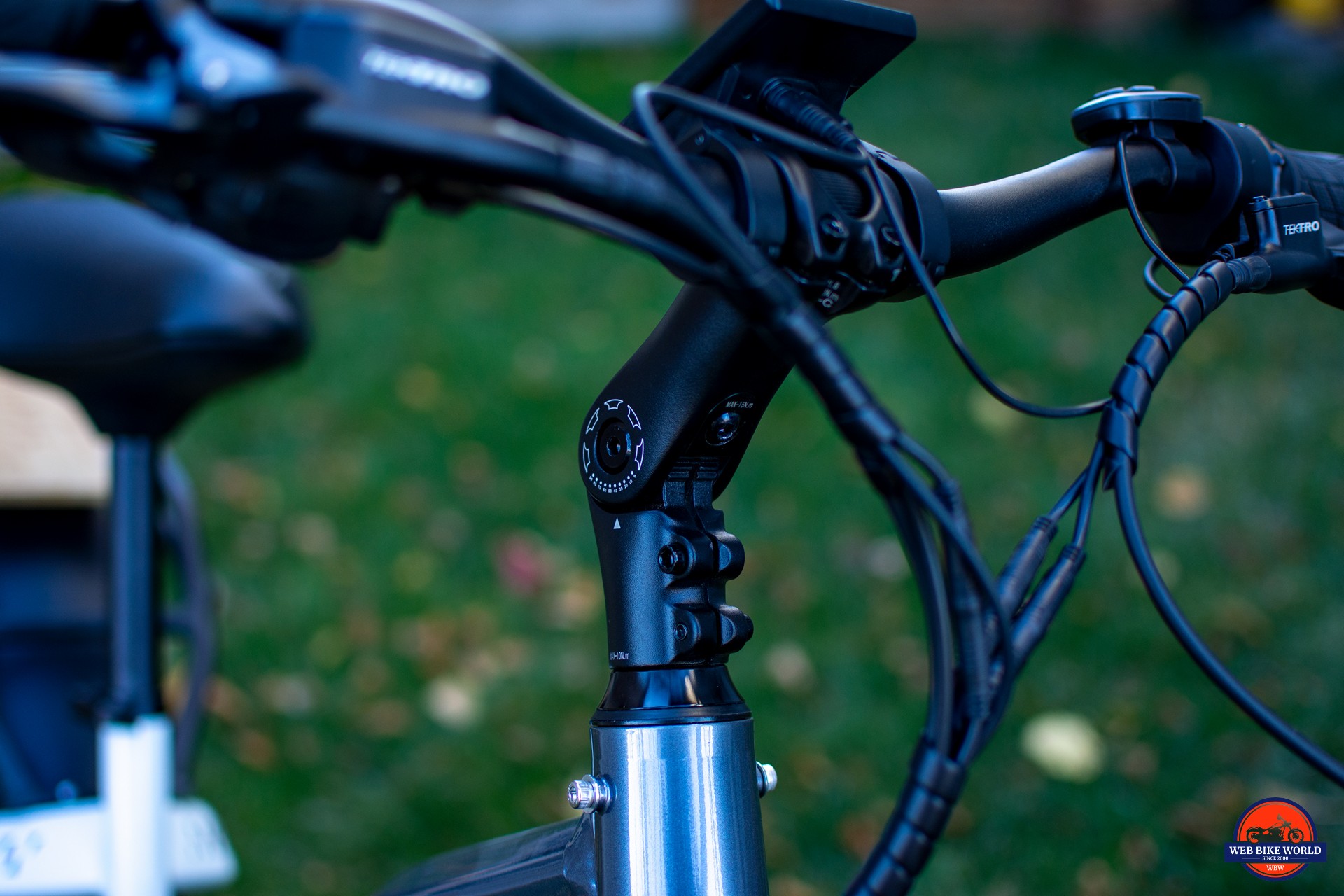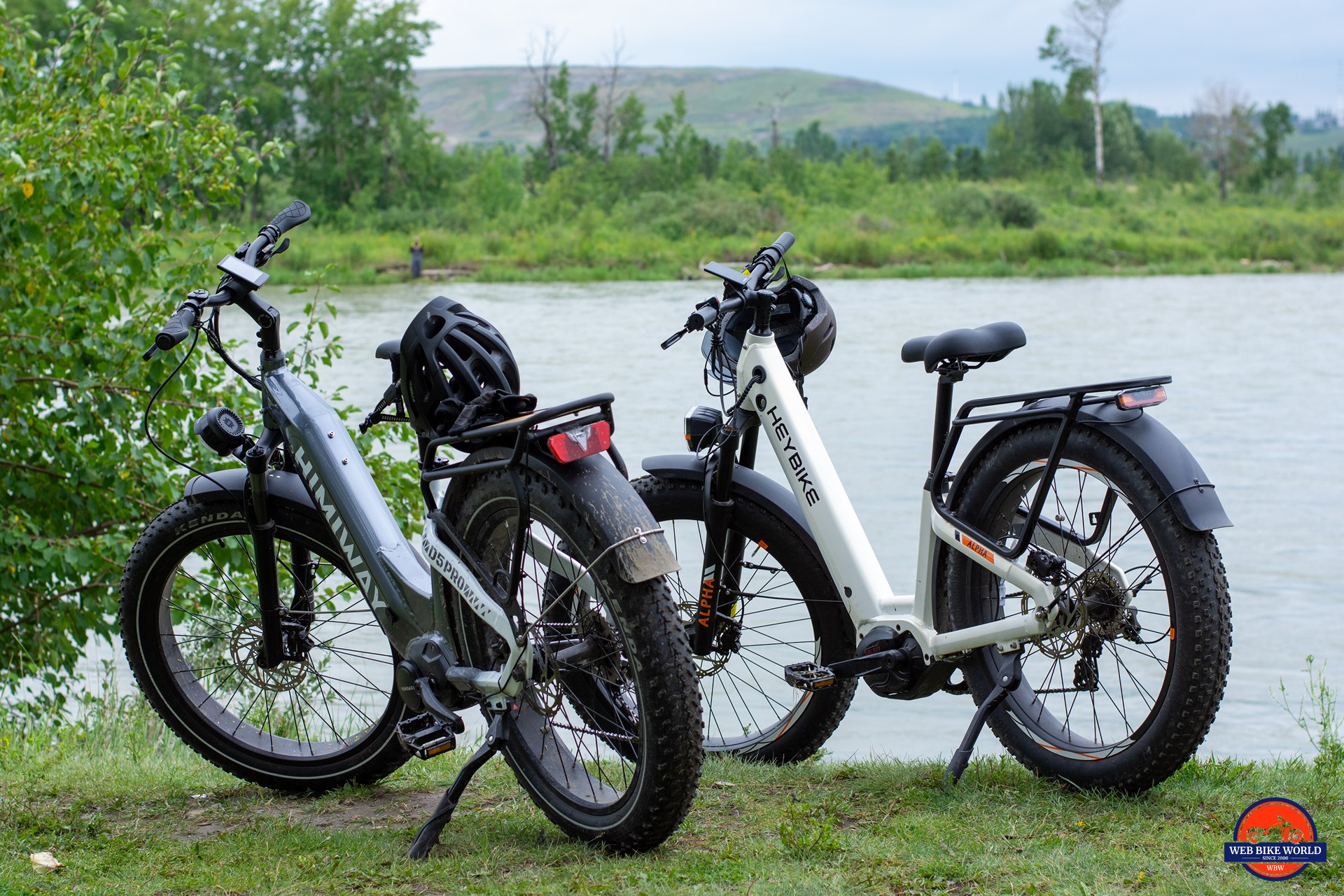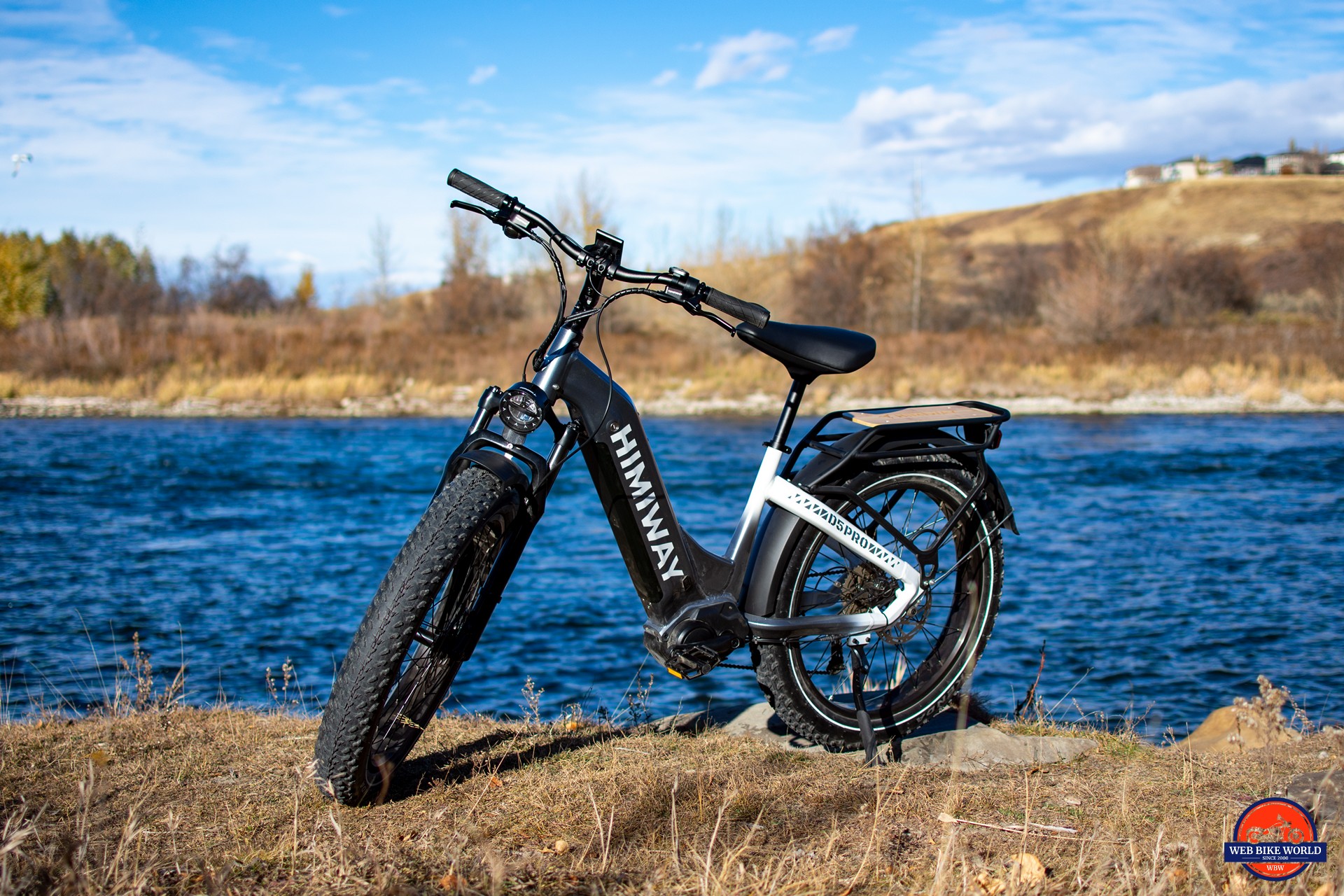Himiway has become one of the most successful direct-to-consumer electric bike brands in North America, selling tens of thousands of ebikes annually. Over the past several years, they have continuously refined their lineup, added new models, and expanded their focus. I’ve reviewed nearly every Himiway model to date, and with each iteration, their competence and confidence continue to grow.
The D5 Pro, formerly known as the Zebra Pro, is the big brother to the hub motor D5 I reviewed last year, which I gave top marks for its impressive performance and features (except for its unusual saddle design).
With the mid-drive upgrade, the D5 Pro is one of Himiway’s most compelling products: a fat-tire, mid-drive class-3 ebike with a big 20 Ah / 960 Wh battery and a Shimano Altus 9-speed groupset that helps you put that mid-drive power down. The D5 Pro rides on Kenda Krusade fat tires; Stopping this heavyweight are 2-piston Tektro hydraulic brakes paired with 180 mm rotors.
I’ve had the D5 Pro in my possession since May 2024, but due to the reasons explained below, I couldn’t conduct serious testing until May of this year. Fortuitously, this also means that I’ve tested the D5 Pro in all four seasons (although all the photos in this review are from late fall 2024 and mid-summer 2025).
If you’re considering investing in the Himiway D5 Pro, here is what you need to know:
- The D5 Pro is capable of handling most terrain, including sand and snow. I’ve ridden the D5 Pro on moderately aggressive downhills, technical singletracks, and overland through 4 feet of high prairie grass. I’ve crossed shallow streams, navigated muddy trails, and sent the D5 Pro down aggressive trails that it had no business being on. It isn’t always smooth, but it handles it.
- The claimed 80-mile / 128 km range isn’t that far off my real-world experience – During “typical” riding, I was astonished to see the odometer nearing 90 km with 15% life on the battery. Still, when I let the motor really flex and started carving up local hills, my range plummeted to just 28 miles / 45 km on a full charge.
- The D5 Pro is as much a monster truck as it is an ebike – It’s big, heavy, overpowered, and unafraid. On the other hand, while it is capable of rolling over just about everything, it also never feels nimble or spry. It’s a monster truck, not a sports car.
- Brake fade is real and happens sooner than you’d expect – Two trips down one of my favorite ridge trails was all it took for the Tektro hydraulic setup to start to struggle. I did not encounter brake fade during everyday riding.
- The stock saddle is terrible. If you intend to ride the D5 Pro like a bike and pedal along, you’ll want to swap the saddle out for something else—anything else—ASAP.
- The D5 Pro can handle nuanced riding and gentle inputs. The torque-sensing drivetrain is well-configured, providing predictable inputs. As a bonus, you can adjust the pedal-assist settings (PAS) from the stock 0-5 to 0-9, allowing you to fine-tune motor performance even further. It feels relatively natural, much better than any cadence sensor I’ve ridden, and very controllable.
- The suspension fork is the weak link in the package. It provides some cushioning, but it has limited adjustment and seems to struggle with the heft of the bike. An upgrade here would transform how this bike handles.
- The customer service experience is mid – I’m reviewing their bike and had to jump through hoops to get a small replacement part, including dealing with two dealers that provided incorrect guidance and a slow service desk at Himiway.
Having just published my Heybike Alpha review, which is a direct mid-drive fat-tire competitor that rings in about $700 less expensive than the D5 Pro, I’ve spent a lot of time lately in the saddle of these fat-tire monster ebikes while being given an excellent side-by-side, apples-by-apples comparison between what the extra investment buys you.
So, does the D5 Pro live up to its potential as a monster truck? Is it as good in practice as it is compelling on paper?
I had a great time finding out.
Words & Photography: Cameron Martel
Himiway provided a 2024 D5 Pro ST at no charge for this review. webBikeWorld does not have a financial relationship with Himiway. I have reviewed over 30 e-bikes and am an avid trail and downhill cyclist. My “acoustic” trail bike is a 2024 Orbea Occam H30, and my ebike stable is a revolving door (I currently have 7 in my garage).
With thanks to Brayden at Chaos Inc. for posing in some of my photos (including the cover) and providing his perspective on the Alpha. For reference, Brayden is 5’9” and 175 lbs.
2024 Himiway D5 Pro Mid-Drive Specifications
| MSRP: | $2,599 USD / $3,599 CAD |
| Where to Buy: | Himiway USA / Himiway Canada |
| Warranty: | 2-year warranty, 15-day return policy |
| Top speed: | 20 mph / 32 kph on throttle alone, 28 mph / 45 kph with pedal assist |
| eBike Class: | Class 3 |
| Range: | Claimed 80 miles / 128 km, wBW observed 45 miles / 72 km during aggressive riding |
| Bike Weight: | 79 lbs / 36 kg |
| Weight capacity: | 400 lbs / 181.5 kg |
| Motor: | Bafang 500-watt mid-drive (they don’t specify which, but it’s probably the M560/M600) |
| Torque: | 130 Nm |
| PAS: | Customizable, 0-9 settings |
| Brakes: | Tektro HD-E3520 2-piston hydraulic brakes with 180 mm rotors |
| Groupset: | Shimano Altus 9-speed |
| Battery: | 48V 20 Ah / 960 Wh with Samsung cells |
| Wheels & Tires: | Kenda Krusade 26×4” tires on spoked rims |
| Other: | Powered headlight and tail light, rear rack, front and rear fenders, the worst saddle I’ve ever ridden on |
2024 Himiway D5 Pro Aesthetics & Design
The D5 Pro ST (step-thru) is a muscular-looking bike, but I’m not sure if it’s a well-proportioned one; It’s one of the bigger step-thru hardtails I’ve come across. With its bulky seat and motorcycle-esque comfort grips, the D5 Pro seems to encourage you to use the throttle more than it wants you to use the pedal assist.
It doesn’t look as refined as its leaner cousin, the Himiway A7 Pro, a mid-drive full-suspension step-thru commuter, nor does it look as athletic as the Heybike Alpha I recently reviewed. There’s a layer of implied athleticism to how those bikes look that the D5 Pro doesn’t have.
Both the step-over and step-thru versions are available in three colorways: Space Grey, White, and Green. Of the three, the green version is my favorite.
A lot of the visual weight that the D5 presents is due to the rear rack and fenders, which are removable if you’re cool with losing your brake light, and the thick downtube that houses the removable 20 Ah battery. If you remove the fenders to clean up the look, you lose the necessary protection that you need with a bike sporting 4” wide tires that throw up a lot of dirt.
While the D5 Pro is chonky, it’s also reasonably practical: a bottle cage mount is located on the top tube, and the rear rack is large enough to strap down a basket, crate, or bag comfortably. Unfortunately, you can’t mount a front basket on this bike.
The Kenda Krusade 26”x4” tires have a more off-road profile than on-road, and that’s to the D5 Pro’s advantage. Himiway markets the D5 Pro as an all-terrain bike, and it very much looks the part. Fields like the above are where the chonk-factor pays off and the D5 Pro feels at home.
The D5 Pro looks kind of like a bodybuilder, and as a former bodybuilder myself, I can’t say that like it’s a bad thing 😉
The Elephant in my Garage: A Less-Than-Stellar Service Experience
During assembly of the D5 Pro I was either missing or misplaced a small bearing cap for the front wheel. Without the cap, the wheel moved slightly from side to side. Both wheels have thru-axles, so this was less of an immediate safety concern and more of a problem regarding premature wear and bearing failure.
So, for nearly five months after receiving the bike, it sat in my garage assembled and awaiting the part.
Why five months? That’s because it took that long to obtain the correct information from Himiway and the right part to get the bike ride-worthy. I received this D5 Pro May 2024, and it wasn’t until October 2024 that it was repaired and ready to ride.
When I realized the issue, I reached out to my contact at Himiway, their support team, as well as two local Himiway dealers, providing them with photos and videos of the problem I was facing. It was ultimately a successful endeavor – the support team got me sorted in the end – but the dealers were no help, and the process took much longer than I expected.
Both dealers told me that I had to replace the entire fork, which would have been several hundred dollars and some wrench time that I knew was unnecessary; Furthermore, neither dealer had a replacement fork in stock! Following that recommendation, I opted to exclude the dealers from the conversation and work directly with the support team at Himiway.
Finally, in late October 2024, nearly five months after the bike arrived for review, the right part was delivered, and 45 seconds later, the D5 Pro was trail worthy once again.
As a product reviewer, I make a point of not commenting on the customer service experience, as I don’t have a fair assessment of it, especially when a brand provides a product for testing through their media team. I typically have access that a regular customer would not.
I am concerned that if this were my experience, what would the typical customer’s experience be like if they encountered a similar issue?
What this experience has demonstrated is the importance of having a good local bike shop/mechanic who knows ebikes. Big thanks to Steve Tunes Bikes for his help diagnosing the issue and getting the D5 Pro back on the road, as well as the team at EBikes Calgary for helping me troubleshoot the problem.
What’s the Himiway D5 Pro Like to Ride?
I’ve already described the D5 Pro as a monster truck, and if you’re picturing a 79 lb ebike steamrolling over obstacles while playing through the dirt, well… you’d be pretty bang on. Yes, the D5 Pro is capable, but it also comes with some limitations inherent in its frame style and weight that became apparent the more aggressively I rode it.
The Riverstone Test Loop (Modified Edition)
Every ebike I’ve ever tested has ridden a 14.5 mile / 23.5 km loop, which winds through Calgary’s Fish Creek Park, that I’ve dubbed “The Riverstone Test Loop”.
The Riverstone Test Loop is a nice mix of paved trails, dirt singletracks, grassland, climbs (both paved and off-road), technical descents, and short but aggressive downhill sections. It winds along a ridge and river valley, and takes riders up and down the ridge several times throughout its route. According to Strava, there’s a total of 850 feet / 260 meters of elevation gain.
However, I was presented with a fortuitous opportunity: it rained 240 mm (about 9.5”) in an 8 day period, meaning that much of the test loop was water logged, washed out, and overgrown. Naturally, with 4” wide tires and 130 Nm of torque on hand, this was the perfect excuse to modify my usual route to see how the D5 Pro handles sub-optimal terrain.
The revised route is almost entirely singletrack, overlanding, and trails with moderate downhill sections; Snaking along both the top and bottom of the ridge, the modified Loop was wet, muddy, and slick to boot: the perfect environment to test a mid-drive monster truck, don’t you think?
Once I had 24 hours of clear weather, I decided to run the D5 Pro as aggressively as I could in situations where it was safe to do so. I wanted to see just how off-road capable the D5 Pro’s TRAMA coil fork and hardtail step-thru frame really was, and whether or not it could match the ability implied by Himiway’s marketing.
After numerous laps over several days, I pushed the D5 Pro’s limits in terms of range, climbing ability, and durability. Here is what I learned:
The D5 Pro’s Strengths
- Despite having ample power from the mid-drive, Himiway has configured the D5 Pro so that it never feels overwhelming. Power cuts out momentarily during shifts or when the throttle is first engaged, and performance of both the PAS and throttle is linear and predictable. Once you’re used to how the motor responds, you can confidently trust that it will do it over and over again. You can also adjust voltage levels for each PAS level via the display menu if you really want to fine tune performance.
- The big battery provides lots of pedal-assisted range. I adjusted the PAS levels to go from 1-9, and pedaling at PAS 2 seems to be an ideal blend of power and range, with PAS 5/6 suitable for the big hills I opted to climb with the D5 Pro.
- The D5 Pro feels balanced and easy to control despite its heft. The battery in the thick downtube keeps it out of the way, and the mid-drive/battery placement seems to be an effective counter to the heavy wheels and tires.
- The relatively large chainring is paired with a halfway decent cassette, helping the D5 Pro hit good speeds at comfortable cadences.
- Overlanding over grassland, dirt, gravel, or sand is a cinch; the D5 Pro instills a lot of confidence as it maintains its composure in sub-optimal terrain.
- Ride quality on most terrain is quite good, especially if you run the fat tires at a low pressure.
- The D5 Pro rarely breaks traction, even when standing on the pedals (and moving weight off the rear tires).
Where it Could Improve
- The 79 lb curb weight would be better served by four-piston brake calipers paired with 203 mm rotors. The stock 180 mm rotors and two-piston calipers do a fine job on paved or groomed trails, but show their limitations when faced with repeated bouts of aggressive braking – like when navigating a complex downhill singletrack – or long bouts of continuous braking, such as when you’re descending a long moderate grade.
- The TRAMA coil fork specs 100 mm of travel, but in practice, it doesn’t feel plush or particularly happy with technical terrain. I’m torn: I like the adjustable fork, but also, shipping a fixed fork could reduce both weight and the price tag.
- The front tire pops off the ground when you are climbing steep hills and hit bumps due to its spring-like fork and torquey motor.
- Changing the stock grips and saddle is a must if you intend on technical riding.
- The large chainring is better suited for a higher top speed than it is for climbing, which is at odds with the fact that the D5 Pro will easily hit its limited top speed (28 mph / 45 kph) in most gears; give me a chainring and groupset that can better handle climbing, please!
Riding Dynamics in Detail
This has been Calgary’s coolest and wettest summer in 10 years (maybe more), and it’s raining on my riding parade. But, when you have a fat-tire ebike with too much power and fenders, the mud becomes an opportunity.
After the first 160 km (100 miles) hit the odometer, I felt I understood the bike enough to get a sense of where its limits were. What is very clear is that light riding – where the trails are smooth and the terrain is gentle – is a non-challenge for this bike, and it’ll handle that riding comfortably all day long.
But after flogging it along 19.5 km (12 miles) of ridge riding in the mud, I have a newfound respect for exactly what this bike can do… which is a lot.
One particularly memorable moment is the time I didn’t go down in the mud.
With the tires at 12 psi, hitting speeds near 32 kph / 20 mph on a water-logged trail in a couple of inches of mud, the rear tire felt floaty as it fought for traction. But find traction it did, and most importantly for me, I didn’t go down into the mud (which was a genuine surprise as I was pretty convinced I was going to eat it more than once).
My other mid-drive hardtail, a custom Surface 604 Shred with 2.8” tires and a Bafang 750-watt mid-drive, would not have handled that slickuation with nearly as much poise.
I’m happy to say that the fenders, despite being flimsy plastic bits, did a damn good job keeping me cleanish despite my best efforts to accomplish the opposite.
By the time I got back to dry ground, I was astonished at my good fortune. By all rights, I should have eaten it… and on any other bike I probably would have.
Where the D5 Pro started to talk back was when I decided to send it down the ridgeside on trails that were overgrown with prairie grass and wildflowers. The slippery terrain was also hilly, with lots of small climbs/descents. The steeper the drop, and the bumpier the terrain, and the more nervous the D5 Pro felt.
The D5 Pro performs best on flowy, simple singletracks that don’t challenge its suspension too much. This describes most inner-city trails that you’ll find in North America.
It can also handle some moderate downs and moderate climbs with relative ease, but it’s during these situations that its structural weaknesses become very obvious.
Deciding to climb the hill above was a daunting choice, as I knew that the odds were 50/50 that the D5 Pro would make it. However, having been surprised already by how capable the D5 Pro was proving itself at handling the ridgeside trails I had already traversed, I felt bullish enough to attempt.
Notably, the Heybike Alpha I just reviewed did not make it up this hill without my middle-aged ass getting off the saddle to walk it up.
From the top of the hill, the view is a bit underwhelming. But also, from the top of the hill is the important part of the story. I wouldn’t say it was effortless, but I probably could have made that same climb five more times before I got tired (and 10 more before the bike got tired).
This is a very impressive result considering how hamstrung the drivetrain is when it comes to climbing and how focused it is on top speed.
However, while the D5 Pro would happily have climbed that hill several more times without complaint, it absolutely did not want to descend that hill several more times without complaint. It was on the second downhill stretch where I noticed the brake fade, and after my third decline, I opted to let the bike take a breather.
The two-piston Tektro HD-E3520 brakes mounted on both wheels are fine brakes in most circumstances, but you can feel them struggle to control a 79 lb ebike down steep hills. The 180 mm rotors simply aren’t enough, and the 2-piston calipers don’t have enough force to control the sheer heft of the bike on these types of trails.
This isn’t necessarily a disappointing result, as the test trails I’m throwing the D5 Pro down were not the ones I expect Himiway had in mind when designing the bike (they’d probably rightly suggest you rock the Cobra Pro for this type of riding). Still, it’s also an important one to appreciate and internalize the learnings of.
Between the powerful motor, intuitive pedal assist, and thumb throttle alongside the robust frame and huge tires, it’s easy to be lulled into a false sense of capability, and that might get you in trouble. This isn’t the bike’s fault, either; it’s your fault for getting excited about what else the D5 Pro can do.
The final segment of the revised test loop begins with a short but aggressive downhill section that features no fewer than eight different jumps. This segment of trail clearly showed the limits of how well the TRAMA fork and hardtail geometry can cushion your ride.
It was bumpy and uncomfortable, albeit still a blast, and no, I did not hit the jumps.
After that, the rest of the ride was essentially flat, save for the long 1.6-kilometer / 1-mile gradual uphill path. By the time I got it home in my garage, filthy and covered in mud, grass, wildflowers, and much more, I had developed a proper appreciation for the D5 Pro and the types of experiences it can empower:
- The D5 Pro will tackle complicated trails, but not quickly.
- It will tackle aggressive downhill stretches, but not repeatedly.
- It will handle mud, tall grass, sand, and more without complaint.
- And it will let you do this for ~70 kilometers / 43.5 miles or so before its charge runs empty.
- Or, if you ride it on pavement, groomed trails, and city paths, you’ll get closer to 90 km / 65 miles of range, assuming you’re using PAS 1, which is a pretty impressive real-world result.
Despite its limitations, the D5 Pro does so much more than I expected of it. I am thoroughly impressed.
2024 Himiway D5 Pro Build Quality & Components
Himiway has mixed some OEM parts (bearings, hubs, etc.) with brand-name components. The brakes, groupset, and tires are all decent quality entry-level components suitable for the price point, as is the Bafang M600 mid-drive motor.
Brakes
With 79 lbs to control, the Tektro HD-E3520 2-piston hydraulic brakes and 180 mm rotors have their work cut out for them. By no means are these bad brakes, but if you ride the D5 Pro like I do, you’ll wish the rotors were bigger to manage heat better, and the calipers were 4-piston to provide sharper and more consistent stopping power.
You could try to upgrade the brakes, but you’d also need to upgrade the fork. Unfortunately, there are still few inexpensive options for 26×4 forks, as the aftermarket hasn’t quite caught up with the ecosystem that is forming.
The Tektros have held up well during a dozen or more sessions up and down the ridge, but a bit of extra oomph wouldn’t be unwelcome. These are big bikes after all.
Motor, Drivetrain, & Groupset
Himiway doesn’t specifically identify which Bafang mid-drive the D5 Pro is equipped with, but I suspect it’s the M600. This 500-watt unit can reach a peak output of 1,000 watts and is extremely capable of handling the D5 Pro. It’s tuned well, and once you get a feel for the throttle input/shift lag, you can control its power easily.
The Altus groupset is fine, and you can roll through its 9-speed efficiently since you can downshift up to 3 gears at a time. However, a small and inexpensive upgrade to a Deore groupset and a 42-tooth climbing gear would turn the D5 Pro into a ridge rocket. Ah, one can dream…
Shifting performance is good, and I haven’t dropped many chains despite consistently bumpy and aggressive rides.
Suspension Fork
The fork is easily the least capable part of the bike. It’s not common for fat tire bikes to come with suspension forks, mainly because you can use the tires themselves to manage ride quality, but direct-to-consumer ebikes challenge that convention since the motor allows the bike to compensate for the added weight of the fork.
While decidedly better than the fork on the Heybike Alpha, the TRAMA fork isn’t up to the level of riding the rest of the bike is capable of. It’s slow to respond at times, especially when the front tire leaves the ground, and it feels springy more often than not.
With an air fork that had 120 mm or more of travel, the D5 Pro would be transformed from something that feels clunky to something that feels confident. This is not an inexpensive upgrade, however.
The left fork features a preload adjustment knob, while the right fork has a lockout. I found that running the preload a little lighter and the lockout a bit tighter was the best combination for mixed-use riding, but your results may vary.
Wheels & Tires
The Kenda Krusades are solid tires for a fatbike at this price point, and their tread pattern is suitable for most riding situations. However, the Krusades aren’t the best choice for winter riding as they don’t take to studs well (the most common complaint is that the tread is too shallow and the lugs don’t get deep enough).
I did ride the D5 Pro in several inches of fresh snow on more than one occasion (10 – 12 psi), but I can’t speak to on-ice performance as I opted not to go there without studs.
Performance in the dirt and grass is quite good, and on pavement, my only complaint is that they’re noisy.
A replacement set will cost you around $150 USD / $250 CAD.
Cockpit
The Bafang color display is easy to read in most situations, save for bright, direct sunlight. Using the control pad on the left bars, you can turn the headlight on/off, adjust the PAS settings, or enter the display menu.
In the menu (hold the “i” button to access it), you can:
- Adjust the top speed of the bike
- Adjust the number of PAS levels (1-5, 0-5, 0-9)
- Adjust the voltage per PAS level
- Adjust trip odometer, display brightness, and other secondary settings
The thumb throttle is easy to use and modulate, and the shifter on the right bars is easy to access, use, and read. Overall, no real complaints here.
I would recommend changing the comfort grips to more traditional grips if you plan on riding the D5 Pro hard, as the comfort grips actually reduce fine control somewhat (but they’re great for cruising with).
Saddle and Accessories
The only thing you’ll want to add to the D5 Pro that it doesn’t come with out of the box is a bottle cage, cell phone holder, and a bell. Otherwise, the D5 Pro comes equipped with everything you need to enjoy it every day.
Note that the D5 Pro does not come with a mount for a front basket.
One accessory the D5 Pro ships with that I appreciate is the adjustable stem, which is perfect for fine-tuning your riding position. This enhances the overall comfort and accessibility of the bike, allowing it to accommodate various needs and positions with ease. This is a thoughtful inclusion for a bike designed for daily riding.
Competitors
Sitting in my garage next to the D5 Pro is the Heybike Alpha, which is nearly identically spec’d in terms of features but offered at a sub-$1,500 MSRP. On the other end of the spectrum are bikes like the Frey CC or Biktrix Juggernaut, both of which cost twice or thrice what the D5 Pro does.
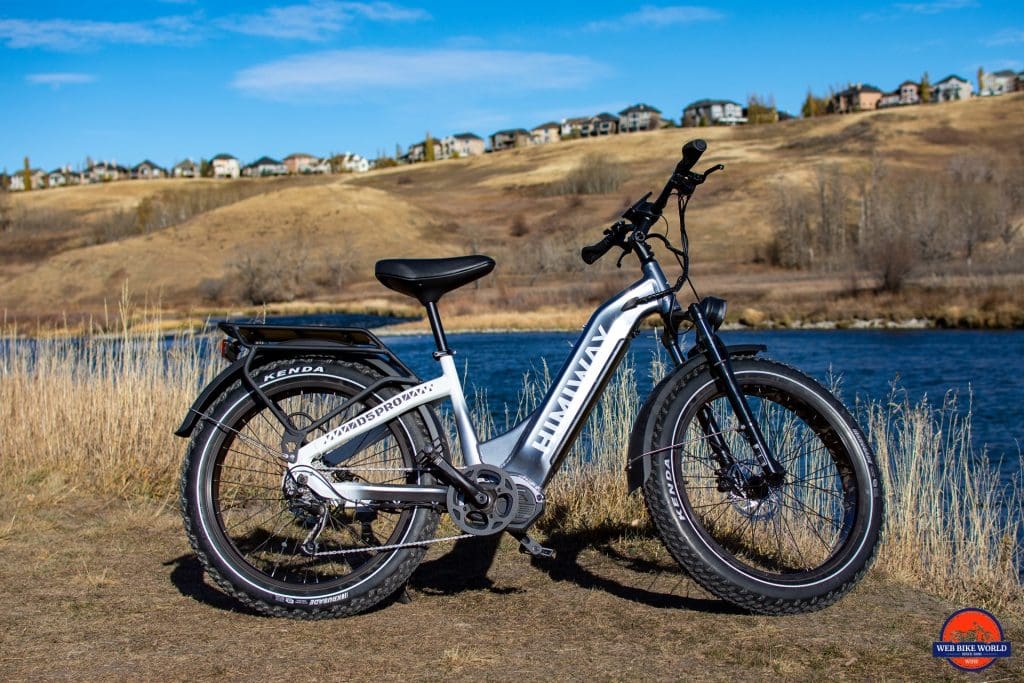
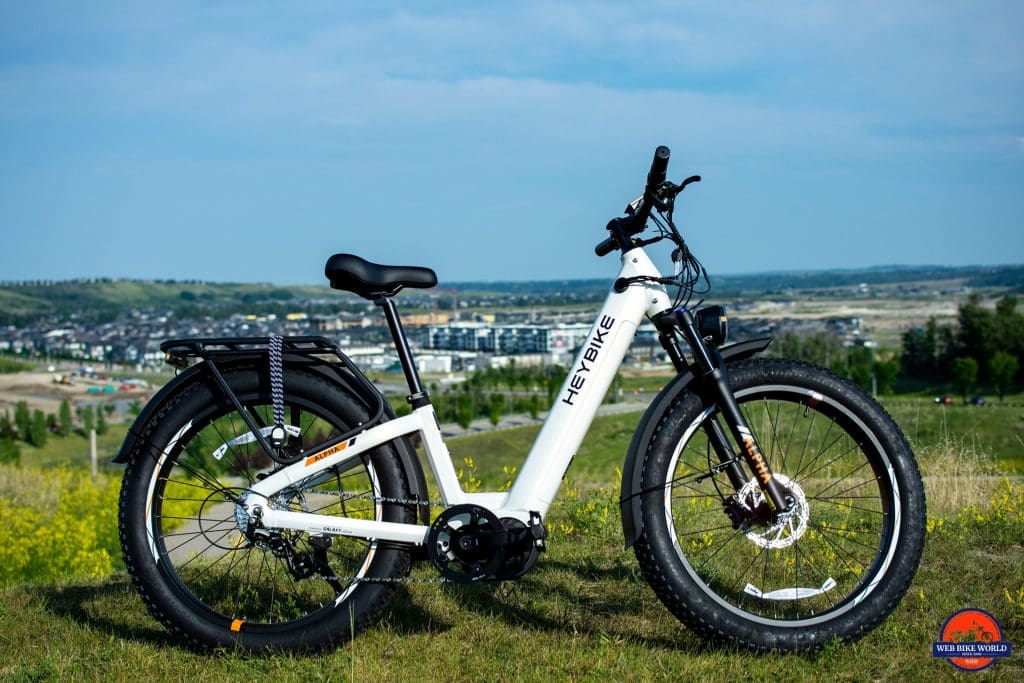
When you ride the D5 Pro and the Alpha back to back, you can easily see where your extra investment is going.
Compared to the Alpha, the D5 Pro is better able to climb hills, is more comfortable in dirt and gravel thanks to its Kenda Krusade tires (vs. the Alpha’s no-name tires), and has a much better throttle (which works like you want it to, unlike the Alpha’s). The D5 Pro is, generally, also a lot more fun.
However, the Alpha has narrower handlebars and a lower profile. It feels more nimble than the D5 Pro, but don’t take that as a guarantee that it is actually nimble. It will outperform the D5 Pro on flow trails without much loose terrain, and I have to admit that the Galaxy motor on the Alpha feels more intuitive with how it delivers power down.
Between the two, the D5 Pro is the one I’d buy if I could afford it, but the Alpha is the one I’d happily rent for a day to throw around.
The D5 Pro is the Affordable Mid-Drive Monster Truck You’re Looking For, & the Best One at This Price Point
The D5 Pro is not the only mid-drive fattie out there, but it is one of the most affordable and probably the best value given its combination of components, battery, and drivetrain.
I am impressed by the potency of its Bafang mid-drive and how well Himiway has it configured. While I wish it had a better fork, I also appreciate that it’s $2,000+ less expensive than better-equipped alternatives from Biktrix, Frey, etc.
However, there’s also the fact that you’re buying from a a largely direct-to-consumer brand, albeit with a growing dealer network, and service might be an issue. My experience is a good example of where this D2C model falls short. There’s no reason it should have taken as long as it did for Himiway to resolve the issue with my review bike, especially considering I provided them with photos/videos of the problem.
My challenges with customer service aside, there’s no denying that the D5 Pro is a rock-solid bike for the money and an outperformer in the affordable fat-tire segment.
I’ve ridden the snot out of this bike and taken it places that it really wasn’t designed to go. I’ve ridden it into tree stumps, through 5” of water, and through miles and miles of mud. I have a blast every time I take it out, and by the time I get back home, my smile is from ear to ear.
If you’re wanting a powerful, big-batteried fat-tire bike to daily ride, and you don’t want to spend more than $2,500 USD / $3,500 CAD, the D5 Pro needs to be on your list – especially if you can service it yourself or have a relationship with a local bike shop.

